Physical Address
304 North Cardinal St.
Dorchester Center, MA 02124
Computed tomography (CT) is the widely recognized imaging standard of reference for the assessment of most pulmonary abnormalities ( Fig. 4.1 ). With a diffuse lung disease (DLD), the high-resolution option is used. An actual collimation of 0.5 to 2 mm and an edge-enhancing algorithm for high spatial frequency reconstruction serve to generate the final images. , The narrow collimation reduces the voxel size, thereby minimizing the averaging of densities (attenuations) within them; this makes it possible to render subtle anatomic details (down to 0.1–0.2 mm in the most favorable conditions). A limitation is the noise of the image because of the reduced radiation penetrating such small voxels. However, at the pulmonary level, the difference in attenuation (contrast) between lung structures and air is high; thus, the signal is high and the final signal-to-noise ratio remains adequate for diagnostic purposes.
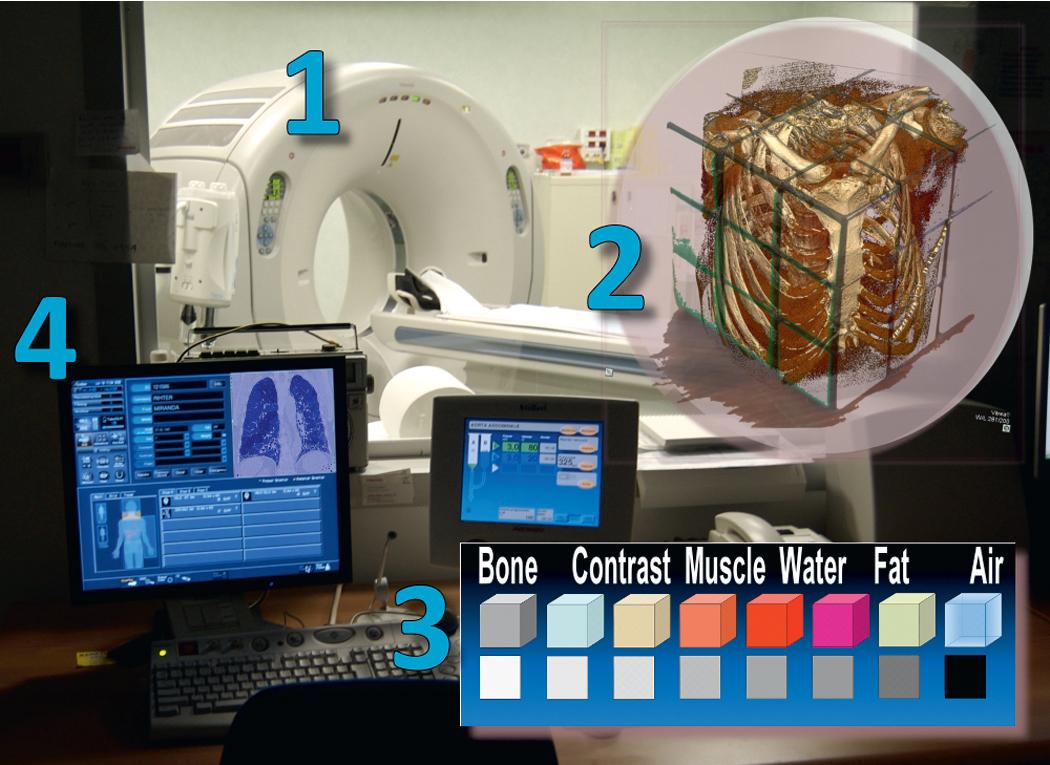
Spiral CT is able to show images of equal quality along planes in any direction, indeed the axial (transverse), frontal (coronal), and sagittal (lateral) views are used more commonly ( Figs. 4.2–4.5 ). For each view, a stack of images may be seen in sequence simply by browsing at the workstation through the volumetric data set; at the end of the diagnostic process, the entire volume is investigated from multiple points of view.
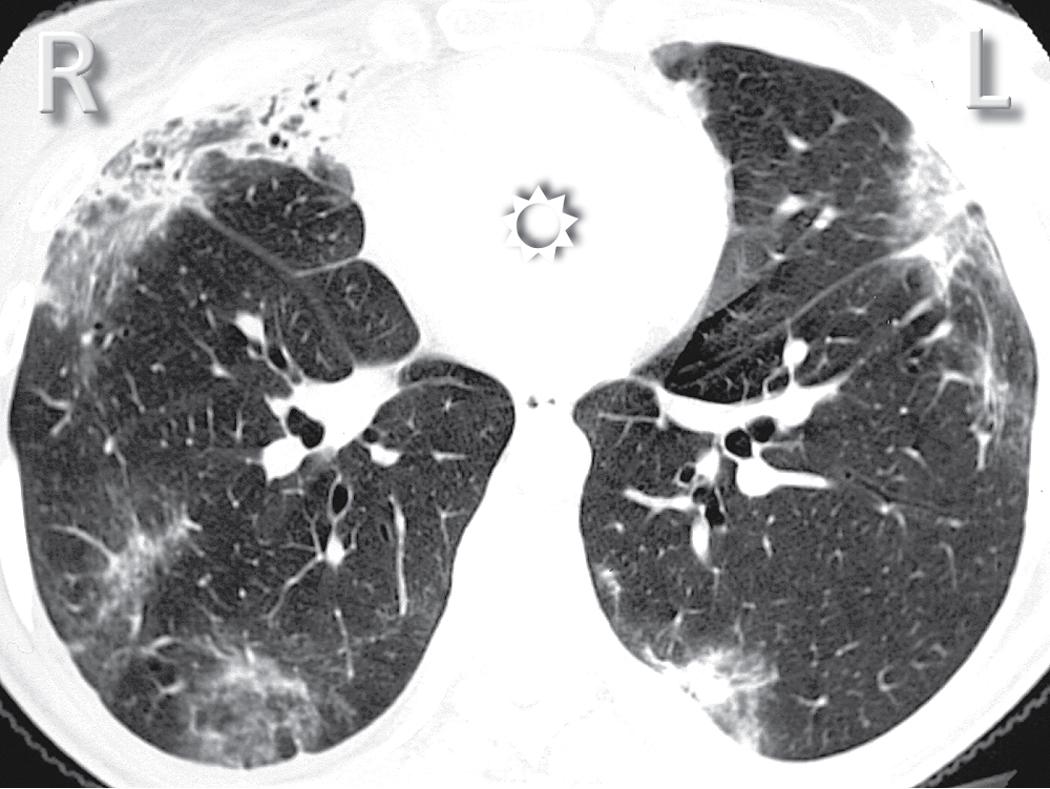
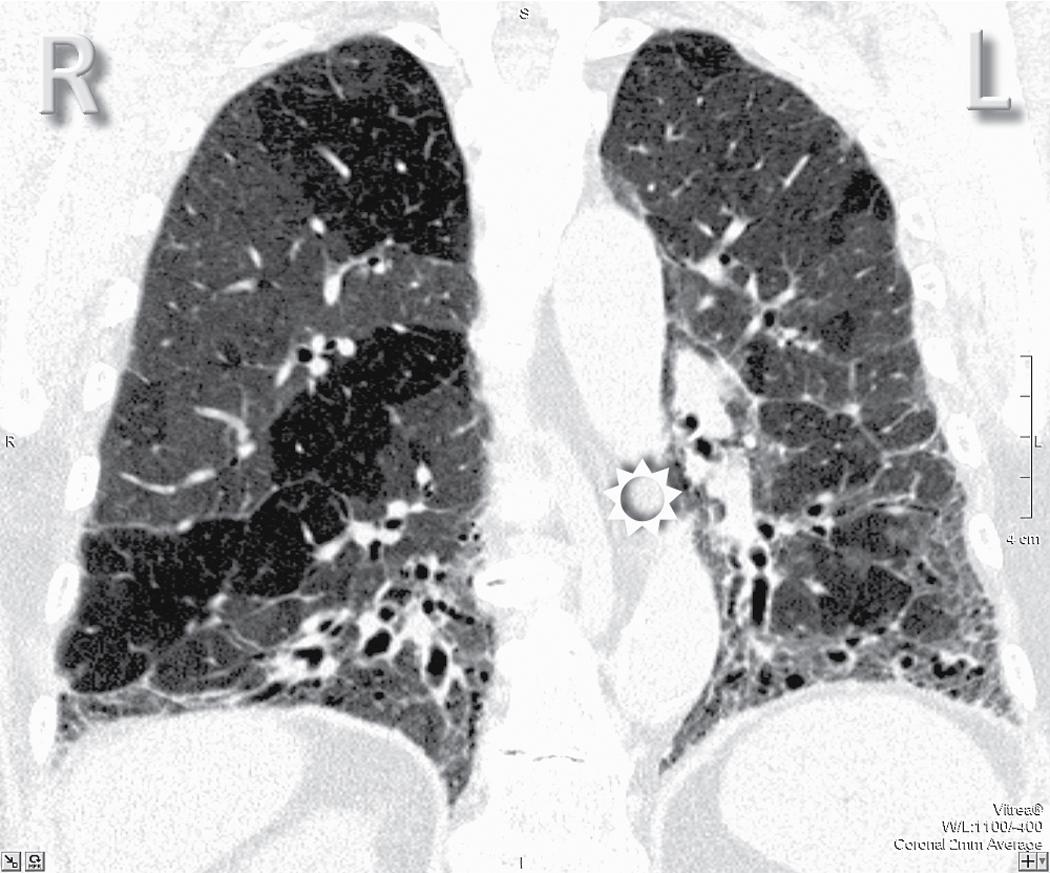
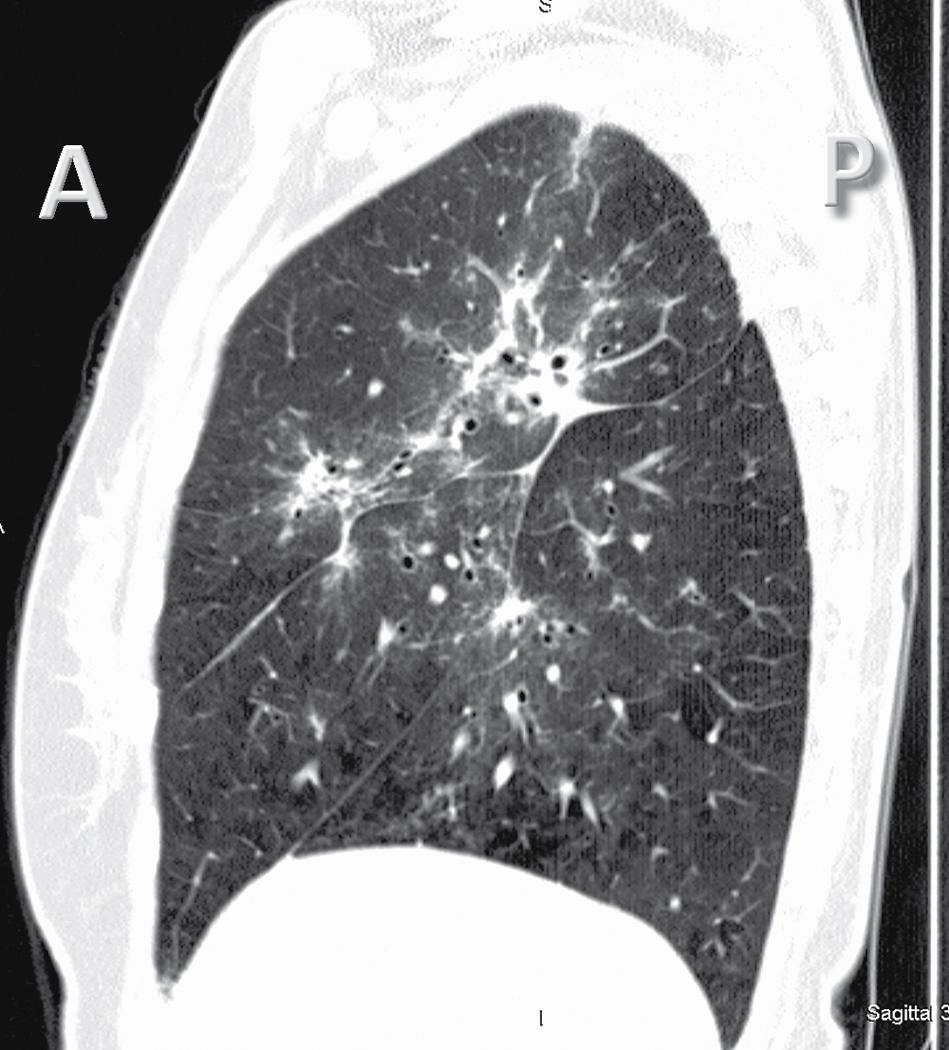
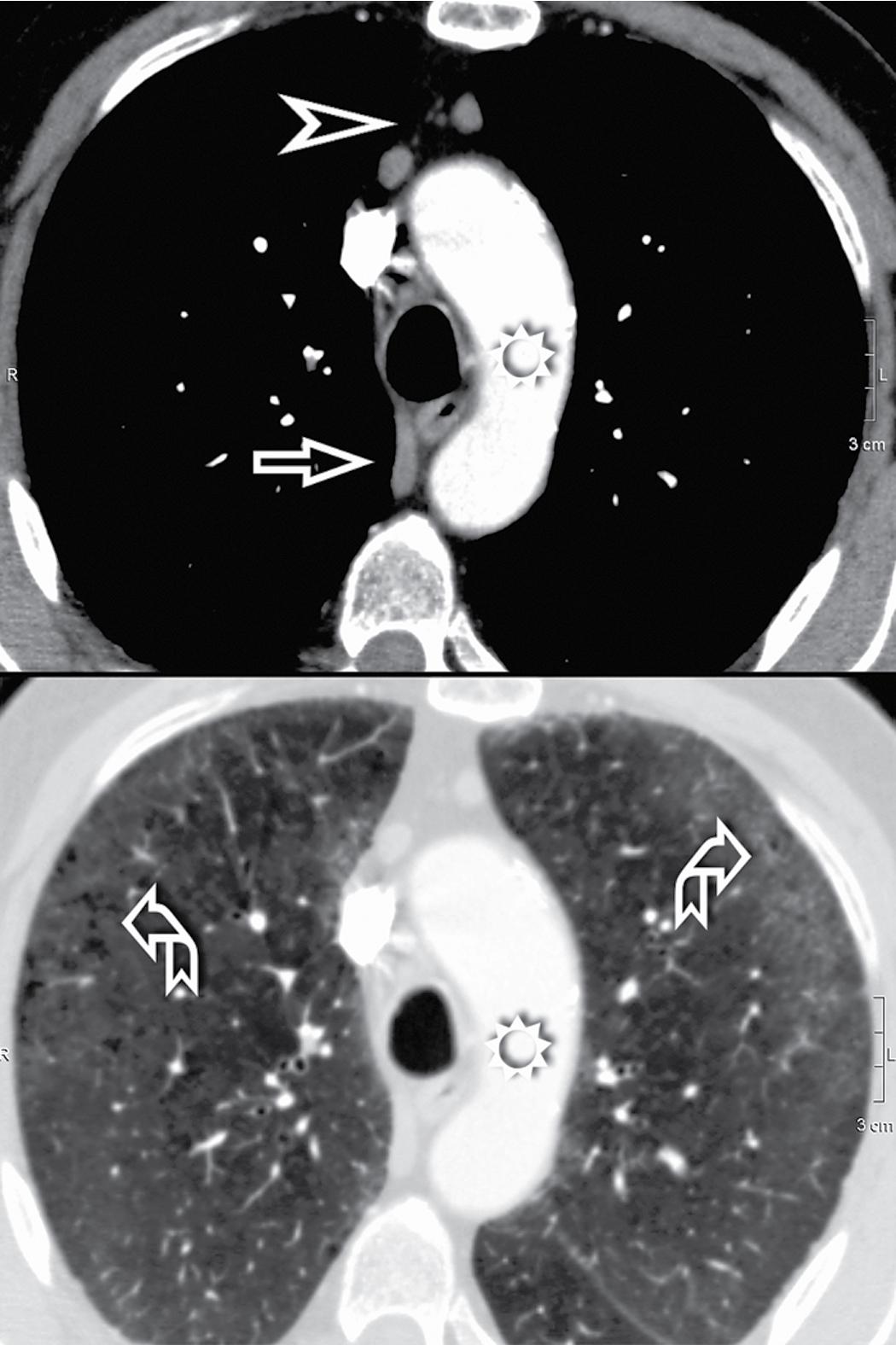
Different CT window settings allow you to view different structures (parenchyma vs. mediastinum). “Mediastinal window” optimizes the contrast of the details at the soft tissue level. The “lung window” optimizes contrast at the lung level, allowing the recognition of parenchymal lesions (see Fig. 4.5 ).
On CT the blood vessels appear roundish or linear depending on the plane of section. Their size should be appropriate to their position within the lung (central vs. peripheral) ( Fig. 4.6 ). Each pulmonary artery is joined by a companion airway, characterized longitudinally as a pair of tapering whitish lines separated by air, which branch regularly (“railway track” appearance). The airways appear as white rings when cut transversely. The outer walls of the arteries and both the outer and inner surfaces of the bronchial walls should present a sharply defined interface with the surrounding parenchyma ( Fig. 4.7 ). As a rule, bronchial walls in corresponding regions of both lungs should be similar in thickness. Moreover, coupled bronchi and pulmonary arteries should present roughly the same diameter, and this in turn depends on their position (central or peripheral). The arteries tend to divide dichotomously, whereas the veins often present a monopodial branching with several smaller branches flowing into a main collection drain.
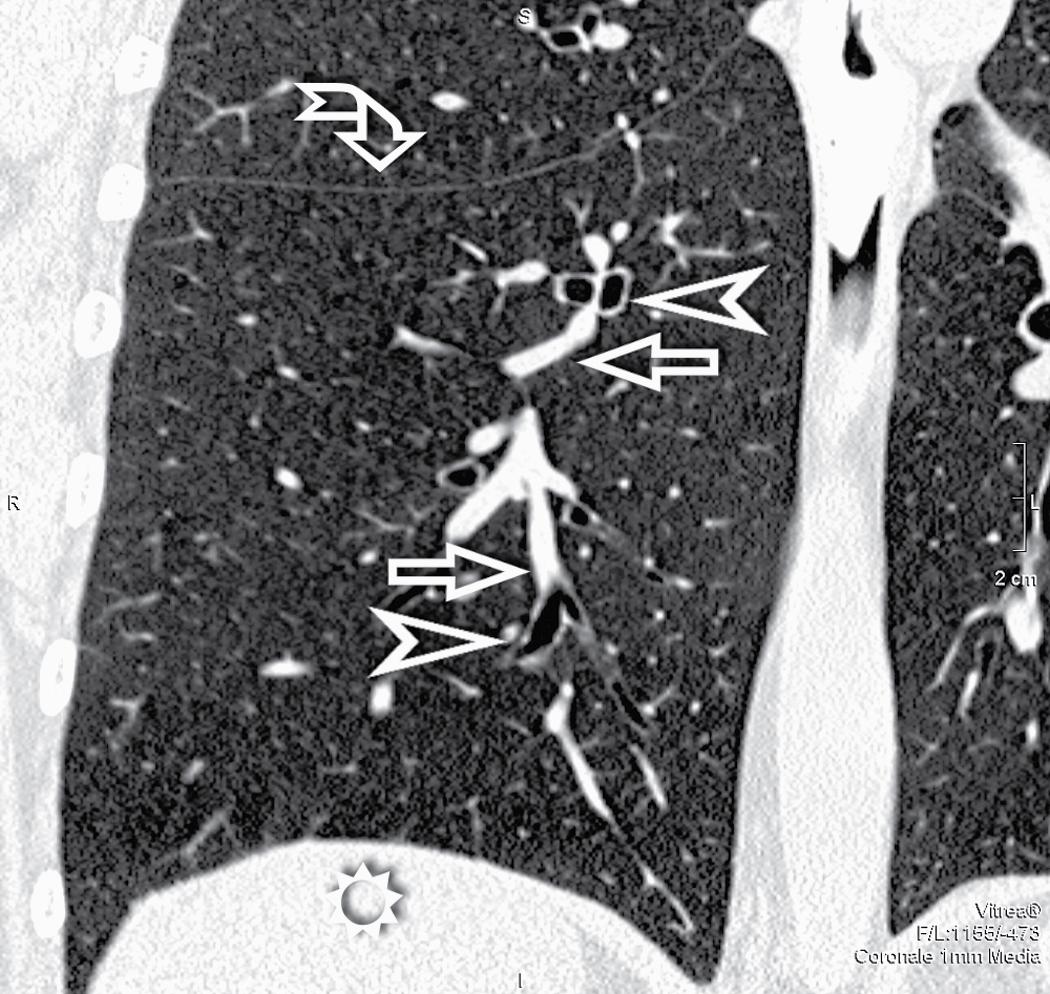
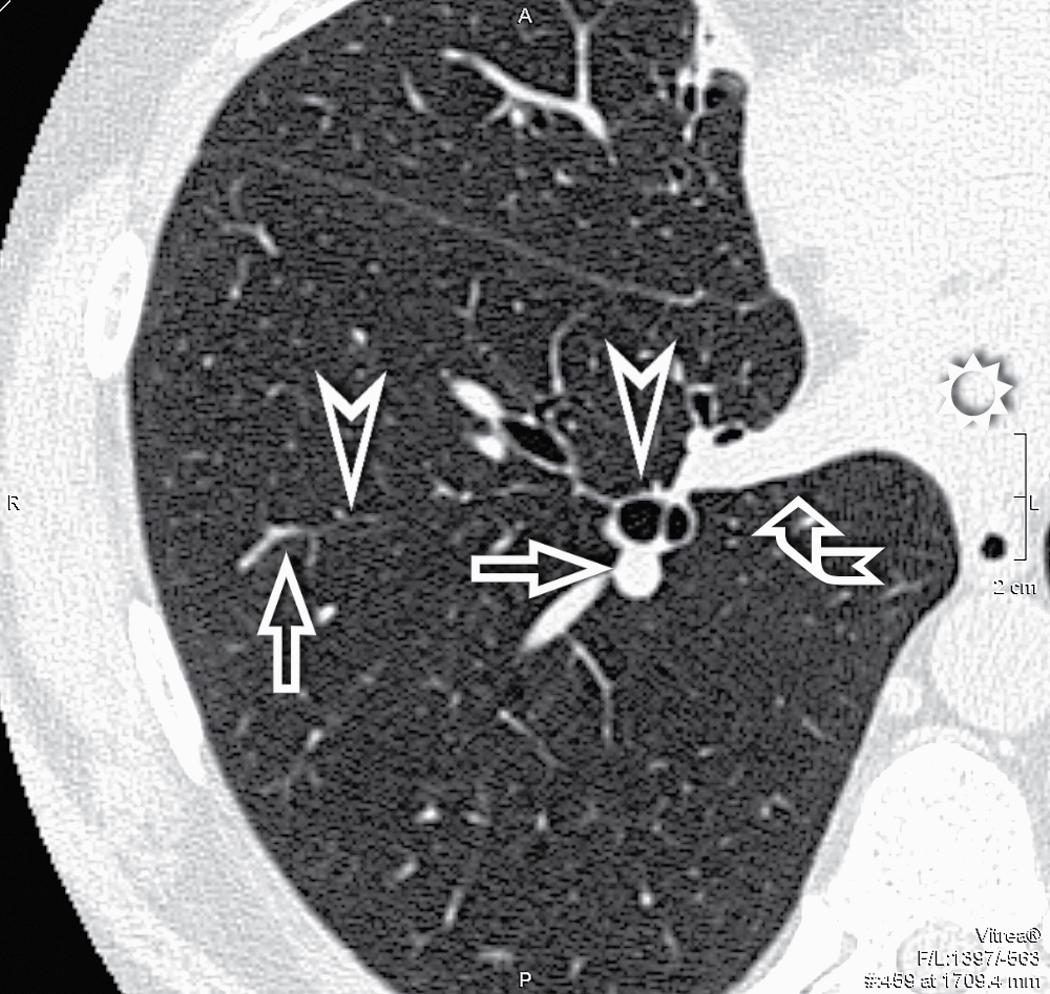
Mediastinal and thoracic pleura are invisible when normal. However, they can appear as subtle tiny linear opacities at the fissural level, where two layers fuse radiologically (see Fig. 4.7 ). When normal, lymphatics are not visible at any level, since their size is inadequate to be perceptible radiologically.
At the periphery of the lung, after 28 generations of arteries and 23 generations of bronchi, arteries and bronchi become so small that they are invisible. Consequently, the far peripheral pulmonary parenchyma should have no visible vessels, and the same and even more is true for the bronchi (see Figs. 4.6 and 4.7 ). Thus, the appreciation of vessels immediately below the pleural surface should point at an abnormality. However, exceptions are possible in the most dependent areas ( Fig. 4.8 ), where the hydrostatic pressure is higher and the vessels larger.
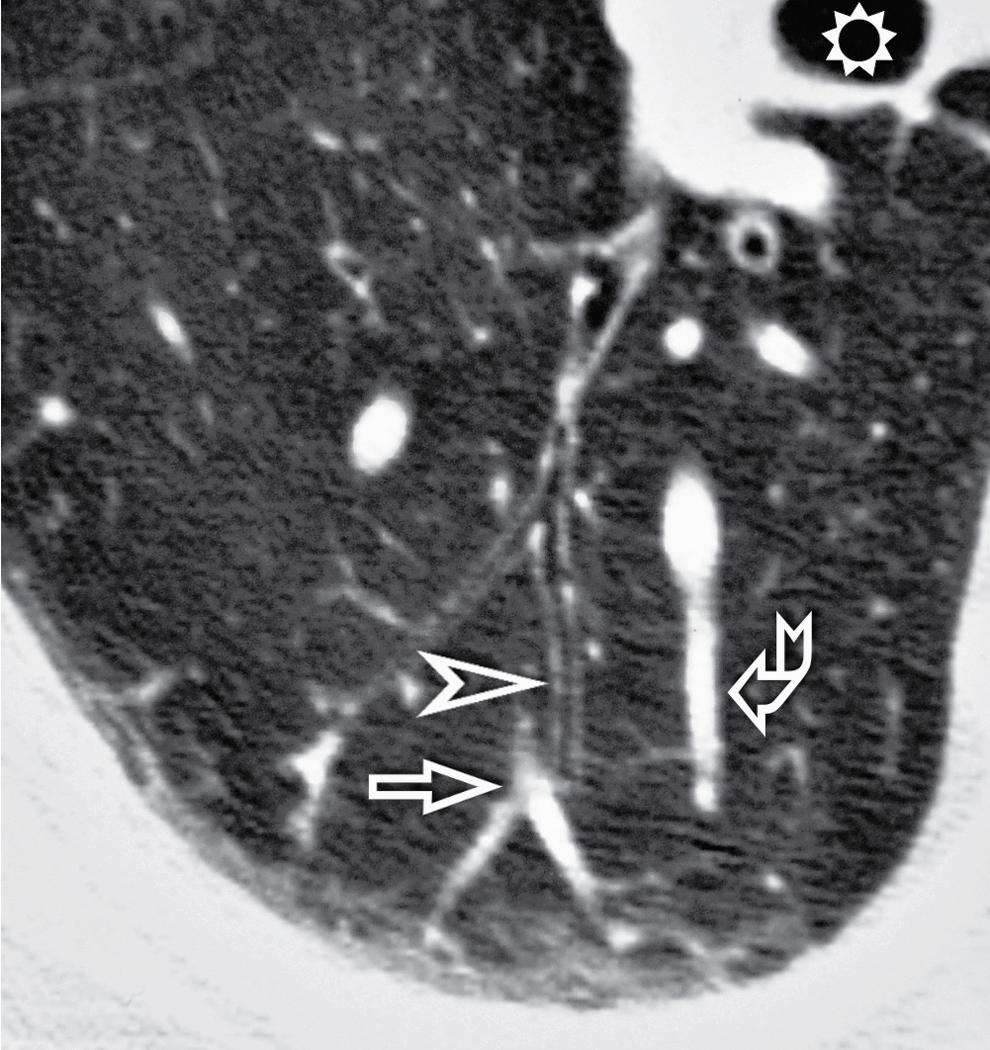
The centrilobular bronchioles, should not be visible, and also, when normal, the interstitial framework at the lobular level should not be appreciable per se. Consequently, when an intralobular network of white lines and/or the walls of bronchioles become visible, it means that they are thickened and hence abnormal. In general, and under normal circumstances, the lobular architecture is discernible only here and there when fragments of centrilobular arteries and perilobular veins are identified; this is more frequent in the dependent portions of the lung (see Fig. 4.8 ).
Spiral CT allows the generation of high-quality images in every spatial plane in nearly every patient (multiplanar reformation [MPR]).
Pathology that occurs in the central or peripheral regions of the lung is best studied in axial images (see Fig. 4.2 ). Diseases that show upper or lower lung prevalence benefit from visualization in the coronal view (see Fig. 4.3 ). Finally, disorders that prevail in the parahilar regions or the costophrenic angles are best depicted in the sagittal view (see Fig. 4.4 ). With the volumetric approach, the planes may be varied according to the needs of the operator and targeted on the suspected disease ( Box 4.1 ).
Hypersensitivity pneumonitis
Langerhans cell histiocytosis
Sarcoidosis
Cystic fibrosis
Pneumocystis jirovecii pneumonia
Idiopathic UIP
NSIP
Asbestosis
Desquamative interstitial pneumonia
Pulmonary hemorrhage
Pulmonary alveolar proteinosis
Renal edema
Chronic eosinophilic pneumonia
Idiopathic UIP
NSIP
Asbestosis
Organizing pneumonia
NSIP , Nonspecific interstitial pneumonia; UIP , usual interstitial pneumonia.
Having the entire volume available and working digitally makes it possible to reconstruct objects traveling in and out of a two-dimensional plane along curved reformatted image (curved MPR). This allows a structure to be traced and displayed as if it were lying along a single plane. For example, an intuitive visualization of the entire course of a bronchus from a cavitated lesion to its origin can be achieved by displaying it along a manually or automatically generated centerline of the bronchial lumen ( Fig. 4.9 ). The curved reformatted images are not real, but they are effective and easy to generate and therefore useful for practical purposes (e.g., virtual bronchoscopy).
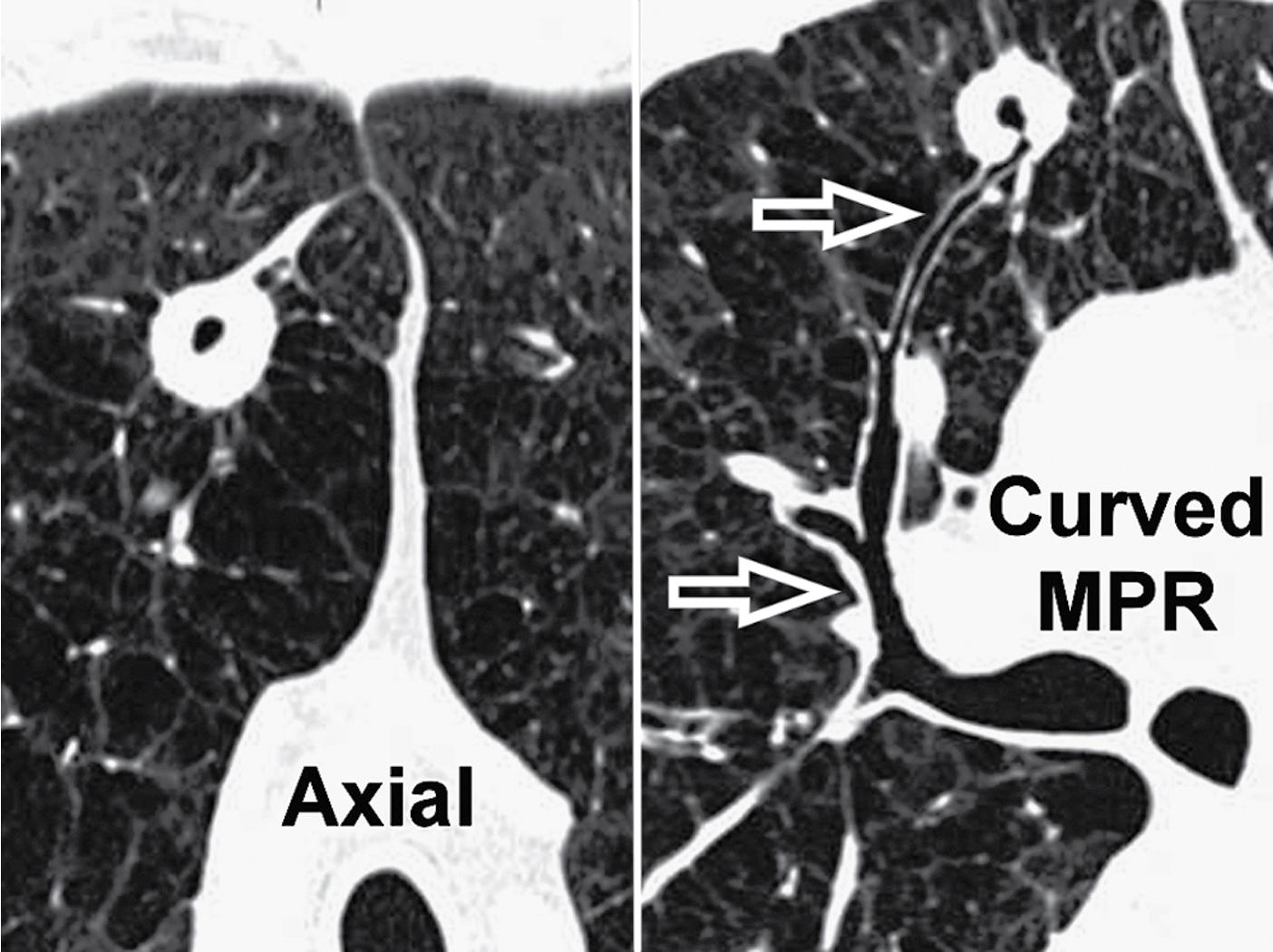
The maximum intensity projection (MIP) technique renders only the voxels with higher attenuation in a thick slice (0.5–2 cm). The technique is suitable for rendering the vascular tree three dimensionally against a black background; moreover, with MIP, it is possible to obtain a comprehensive representation of the position of various lesions inside the lobular framework ( Fig. 4.10 ). In selected cases, MIP images are useful for distinguishing between vessels and nodules and, when nodules are present, to assess their profusion.
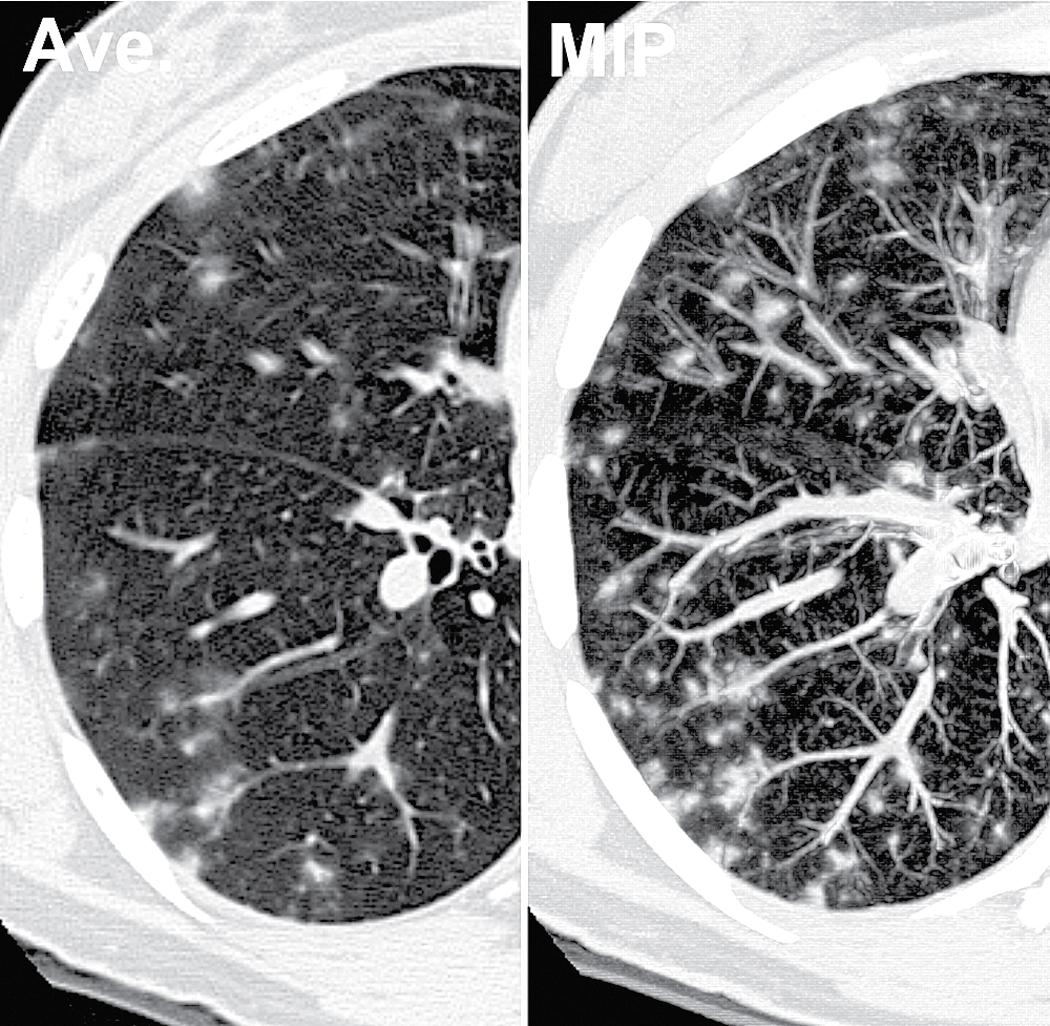
The minimum intensity projection (minIP) technique renders only the voxels with lower attenuation in a thick slice (0.5–2 cm). This technique is useful for improving the visualization of hyperlucent elements (bronchi, emphysema, bullae, honeycombing) and some opacities, allowing for a more precise study of their attributes and distribution. The minIP technique is also ideal for investigating bronchial caliper and course, particularly within areas of increased density ( Fig. 4.11 ).
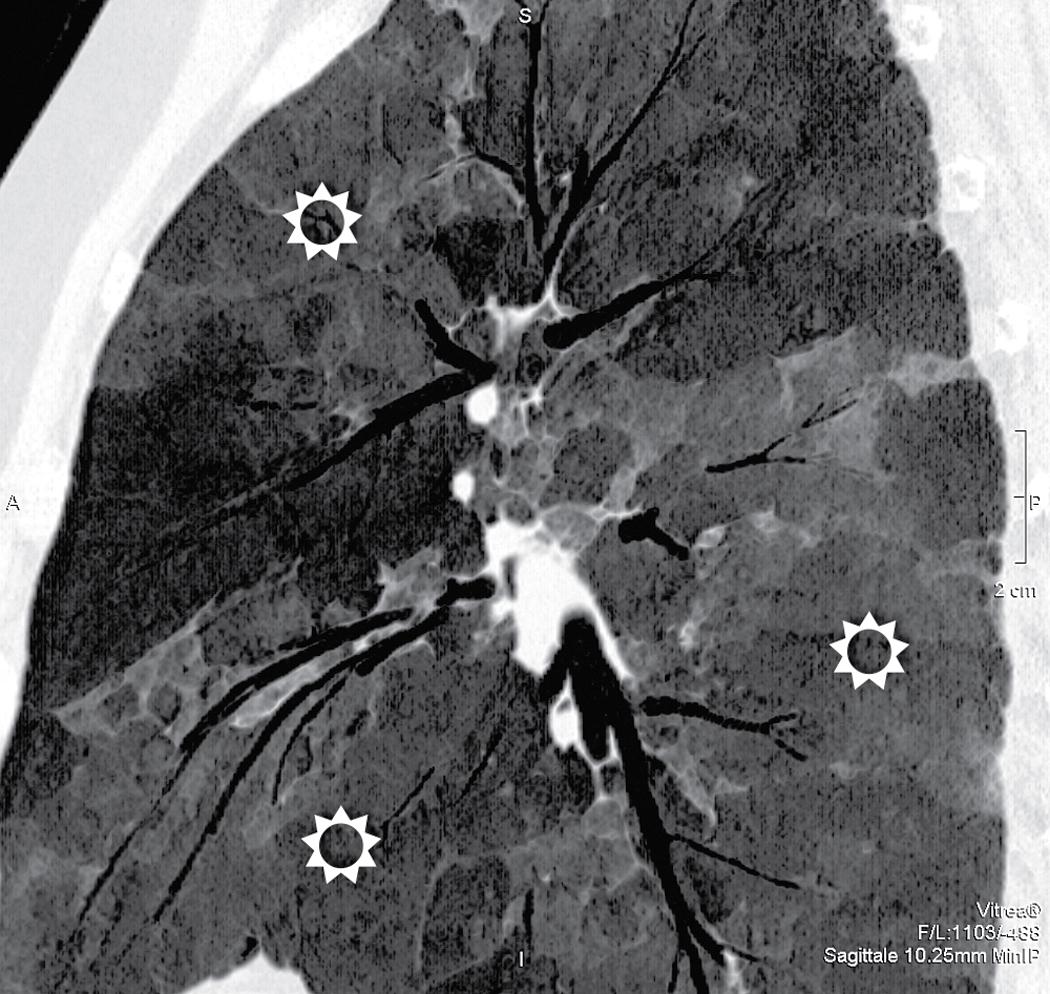
Volume rendering (VR) techniques may also be used in assessing DLD. When this is implemented, the machine renders only the structures within a specific range of attenuations and contained within a chosen volume. VR may be useful for studying a volume of lung in three dimensions from within or for inspecting its surface from outside (external VR) ( Fig. 4.12 ). This is particularly useful for concisely looking at the pulmonary surface and its abnormalities and for helping to make medical decisions (e.g., determining the site of a surgical biopsy).
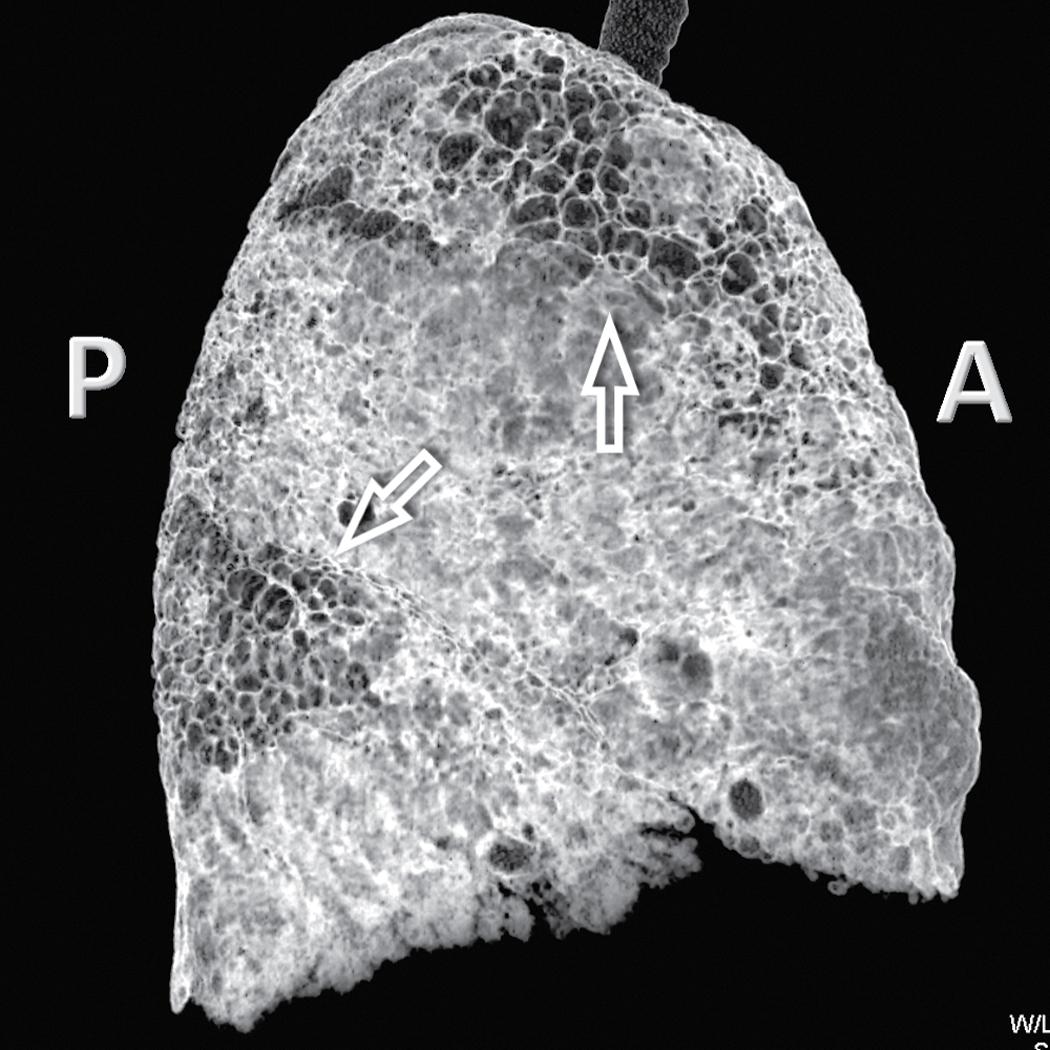
CT examinations are routinely performed on supine patients at the end of inspiration. Then the higher content of air in the lungs allows for better contrast (hence, better visibility) of anatomy and pathology. However, in supine patients, some whiter atelectatic lung is frequently seen in the most dependent posterior areas (see Fig. 4.8 ), where it may simulate pathology or, alternatively, hide it. These normal densities disappear with prone positioning ( Fig. 4.13 ); indeed, some experts recommend the routine use of prone scans when diseases under consideration characteristically involve the posterior lung (e.g., idiopathic pulmonary fibrosis [IPF], asbestosis).

In normal subjects, an expiratory scan shows a uniform reduction in the size of the lungs together with a homogeneous increase in their density owing to the reduced amount of air within the alveoli. When an arterial obstructive or a bronchial stenotic disease is present, variable portions of the lung become darker than normal because of the reduced blood supply caused directly by hampered vascular filling or indirectly by hypoxemic vasoconstriction. In the expiratory CT, however, the hyperlucent areas due to vascular obstruction physiologically increase their density, whereas in the case of bronchiolar stenosis they do not because the air does not exit from the alveoli (air trapping) ( Fig. 4.14 ). When arterial obstructive or bronchial stenotic diseases are suspected, supplementary expiratory scans should be added to complete the investigative process.
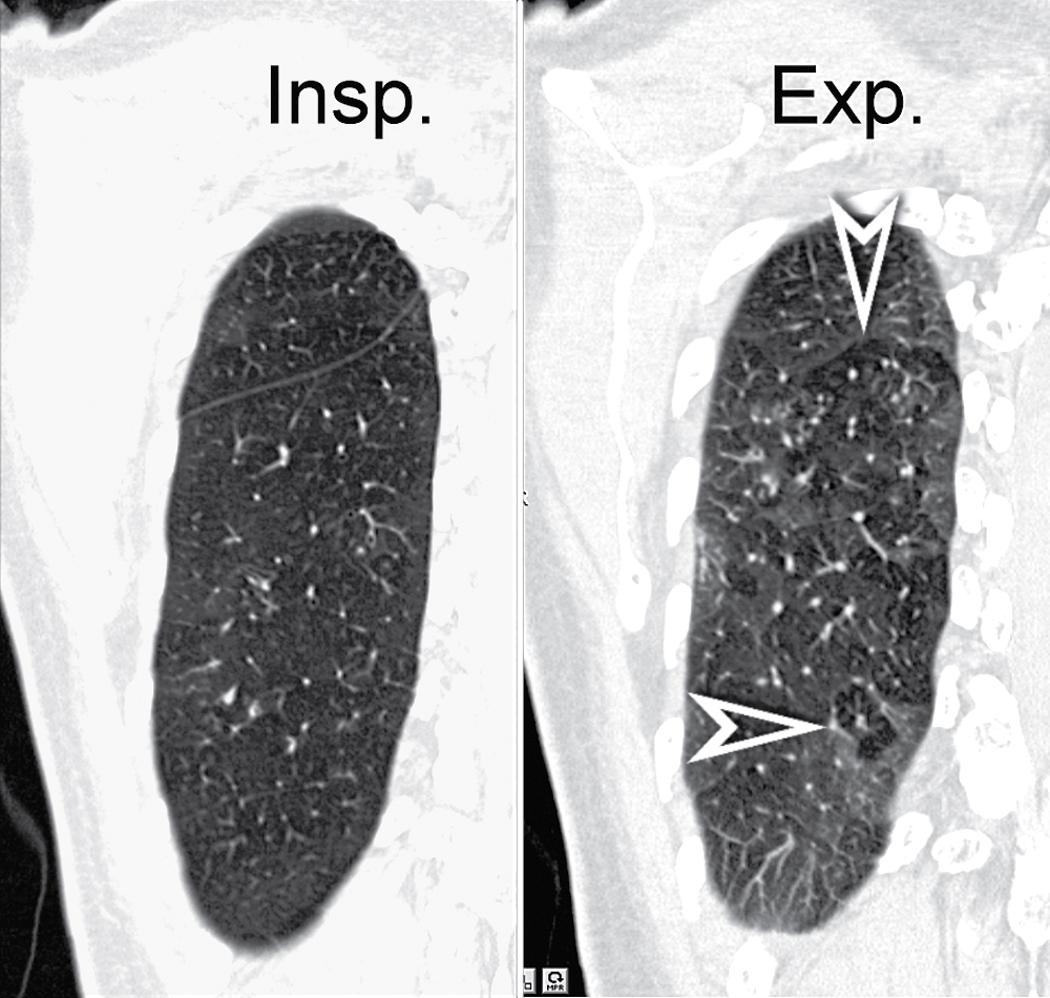
A DLD, also known as interstitial lung disease (ILD) is a pathologic process in which it is not possible to localize unambiguously the topographic site of onset. The radiologic appearance of each DLD depends on the elementary lesions and their distribution throughout the lung. The beginning of the radiologic process should involve verifying the existence of abnormalities, in particular of elements causing increased absorption of the x-rays (opacities) or a reduced attenuation of them (hyperlucencies). If abnormalities exist, the next step should entail identifying their prevalent aspect, which in turn depends on the underlying pathology. Another step should involve localizing the abnormalities, both in relation to the lobular architecture (when possible) and their topographic distribution throughout the lung. The lobular approach presents valuable information about the modalities of arrival/onset of the lesions and their spreading routes, and the topographic approach helps discriminate among diseases with similar presentation.
The lobular approach should be quite obvious for the pathologist, who will find it extraordinarily easy to recognize many radiologic aspects of diseases with which they are acquainted from gross organ inspection (a radiologic image is essentially a black-and-white representation of gross lung examined with a magnifying glass). The possibility of confirming and specifying a disease using its distribution throughout the lung may be less intuitive but will become excitingly new and beneficial with practice. After all, the two modalities are not mutually exclusive; on the contrary, they strengthen each other through the concept of pattern.
Patterns in the practice of medicine are the ensembles of characteristic elements that give proof and name to a disease or a family of diseases. In the DLD universe, basic radiologic patterns play an important role at the beginning of the diagnostic assessment. According to the literature and on the basis of the personal experience, the distinction of six main radiologic patterns is suggested , :
Septal pattern (linear pattern with preserved architecture)
Fibrotic pattern (linear pattern with distorted architecture)
Nodular pattern
Alveolar pattern
Cystic pattern
Dark lung pattern
These radiological patterns match with the pathological ones: septal, fibrosis, nodules, acute lung injury, alveolar filling, cellular infiltrate, minimal changes ( Box 4.2 ).
A septal pattern is present when a thickening of the perilobular interstitium is appreciable, making the lobular boundaries evident. The bronchovascular bundle is also usually thickened, producing changes both at the central parahilar level and in the centrilobular core. The final effect is that of a regular network of white lines with increased evidence of the perilobular interstitial architecture but without retraction or remodeling of pulmonary structures. For this reason, the septal pattern is also called a regular linear pattern or linear pattern with preserved architecture ( Fig. 4.15 ).
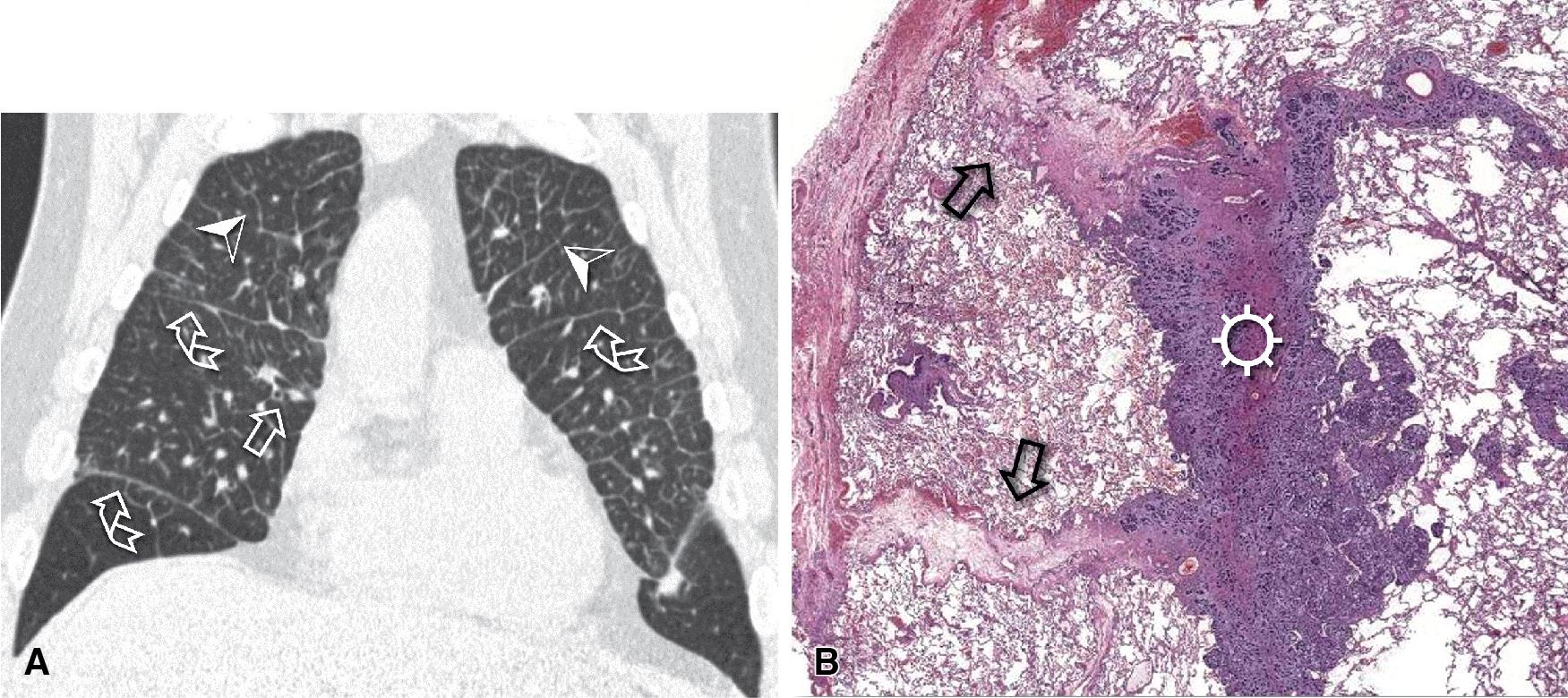
A network of white lines due to thickened septal, peribronchovascular, and subpleural interstitium is the trademark of this pattern. The thickened interlobular septa appear as white lines 1 to 2 cm in length that outline the polygonal boundaries of secondary lobules (interlobular or perilobular reticulation) ( Fig. 4.16 ). This is actually the result of a focal or diffuse lymphatic involvement of the secondary lobule in the form of fibrous accentuation in the absence of both architectural remodeling and a definite nodular predominance. Normally these septa are not recognizable, so their presence points to an abnormality. A few lines inside the lobule may also be visible. ,
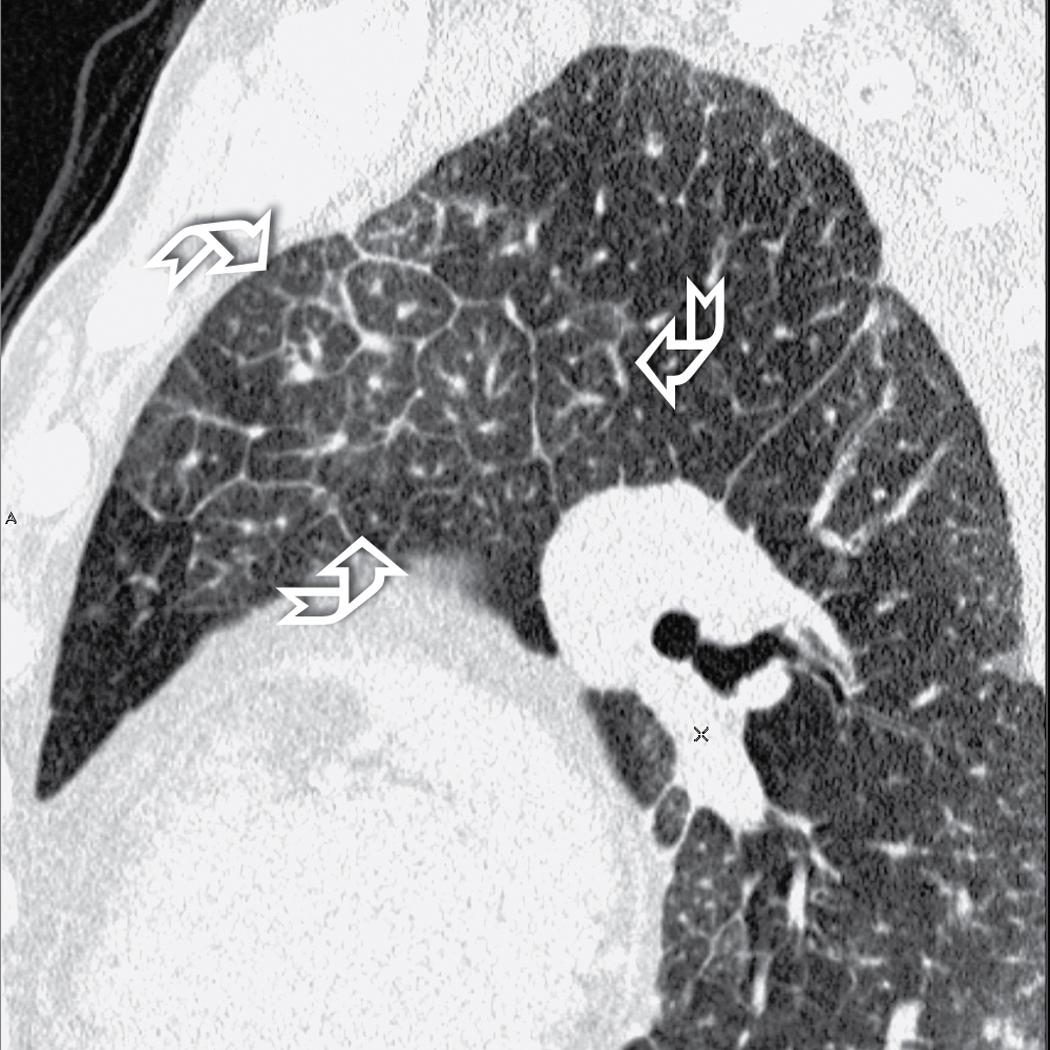
Centrilobular peribronchovascular thickening becomes manifest as a cuffing of the core structures of the lobule. The bronchiole, usually invisible under normal conditions, becomes evident as a white ring adjacent to a white dot of similar size (the centrilobular arteriole). It is enlarged compared with rings identifiable in adjacent portions of pulmonary parenchyma ( Fig. 4.17 ).
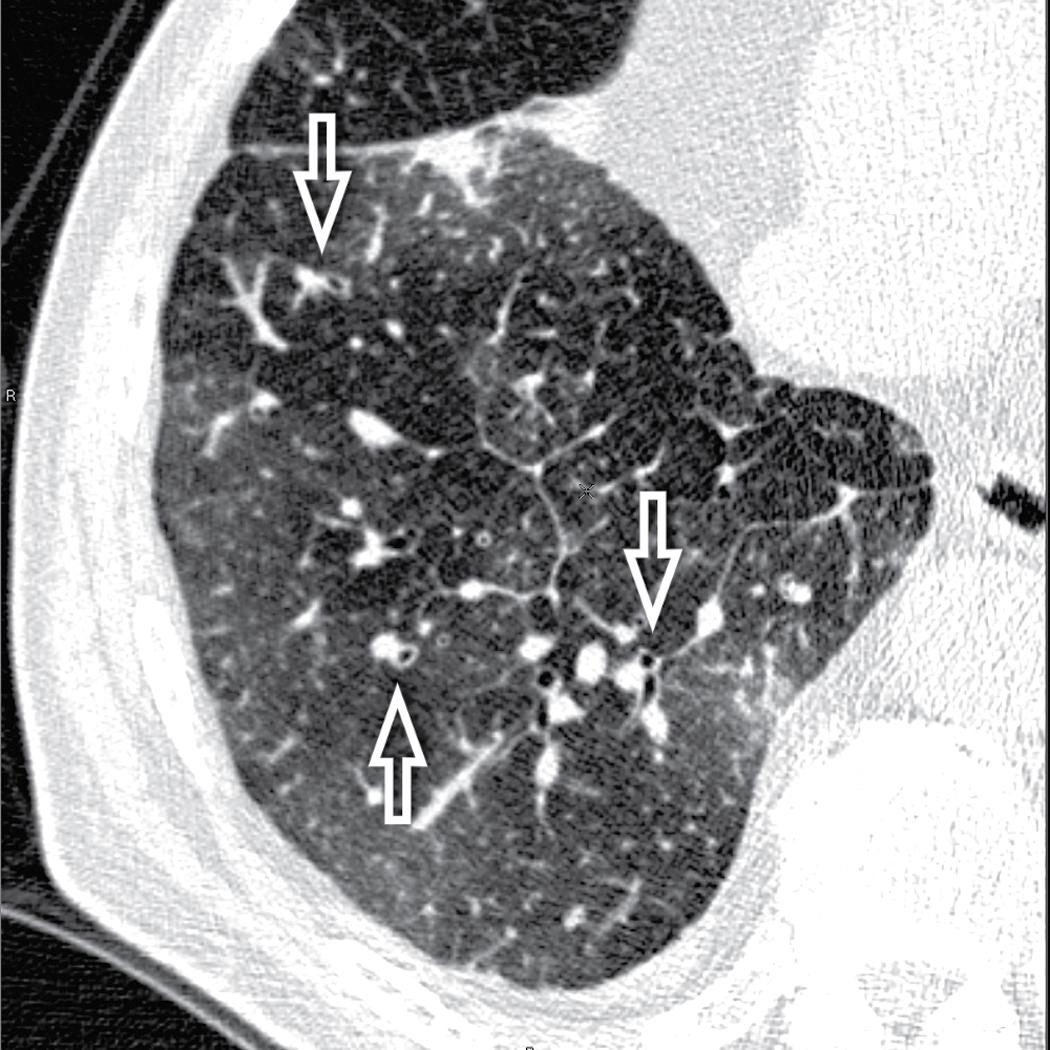
The thickened peribronchovascular bundle at a more central level is also perceived as arteries of increased size compared with similar portions of pulmonary parenchyma and as thickening of bronchial walls ( Fig. 4.18 ). As a rule, vessel size and bronchial wall thickness in corresponding regions of one or both lungs should be similar, and a comparative evaluation of different lung regions is helpful and makes the recognition of the abnormalities easier.

The subpleural interstitial thickening should be evaluated at the edges of the lung and consists of a white enveloping line simulating thickened pleura. This sign is often easier to identify at the fissural level, where two layers of subpleural interstitium coexist ( Fig. 4.19 ).
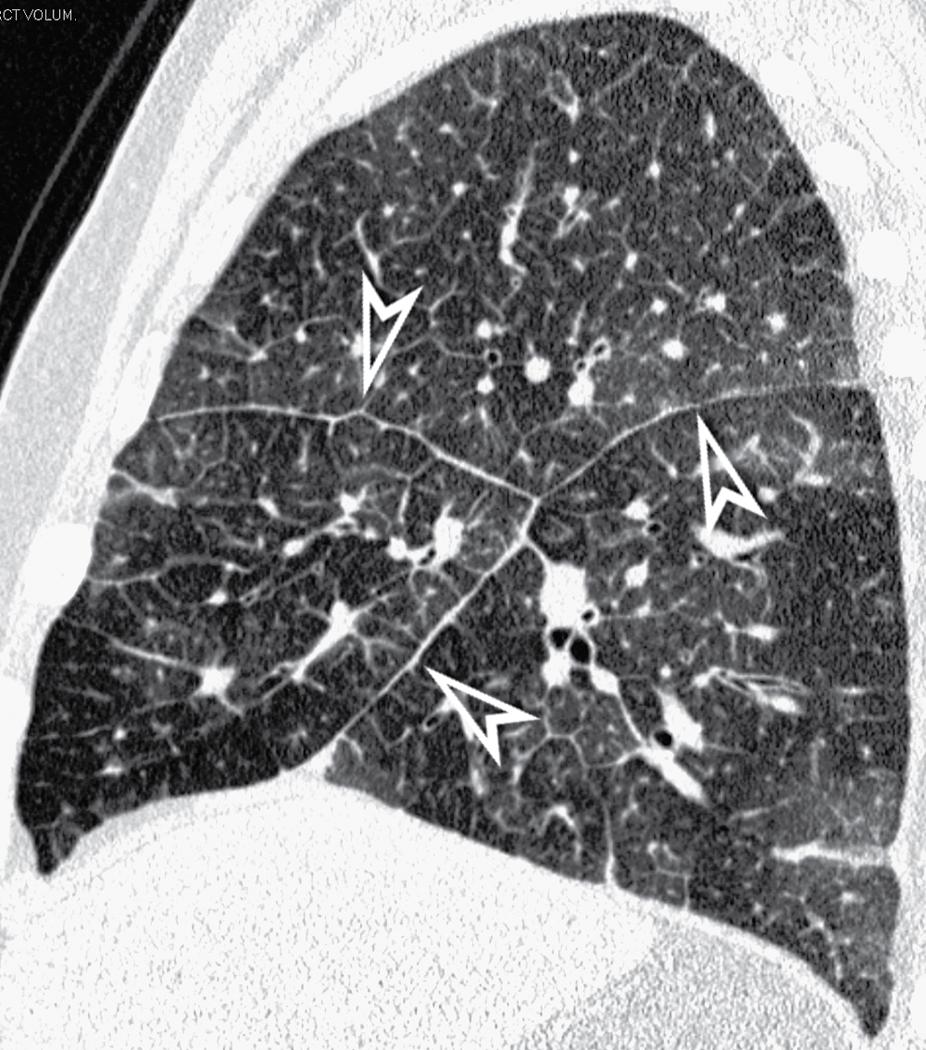
Pleural effusion may be an additional finding in some septal disorders. It can be inconspicuous pleural effusion and may be seen along the costovertebral angles or fissures ( Fig. 4.20 ), where consistent compressive effects on the adjacent parenchyma may be present.
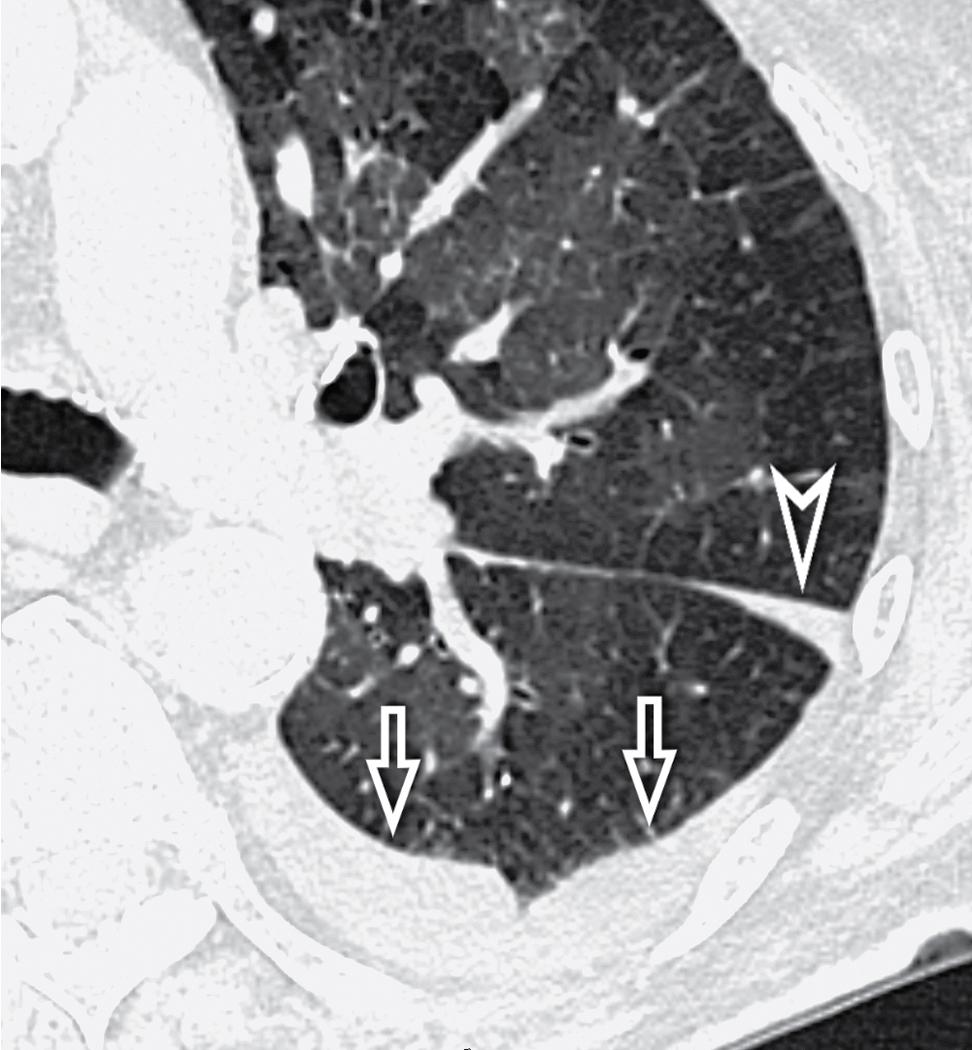
Morphologic characteristics of the septal thickening pattern allow the distinction between two possible subsets of the septal pattern: smooth and nodular. , ,
The anatomy of the three interstitial compartments (perilobular, peribronchovascular, and subpleural) is more or less regularly thickened with smooth profiles. The polygonal outlines of the lobules are visible, without focal abnormalities ( Fig. 4.21 ).
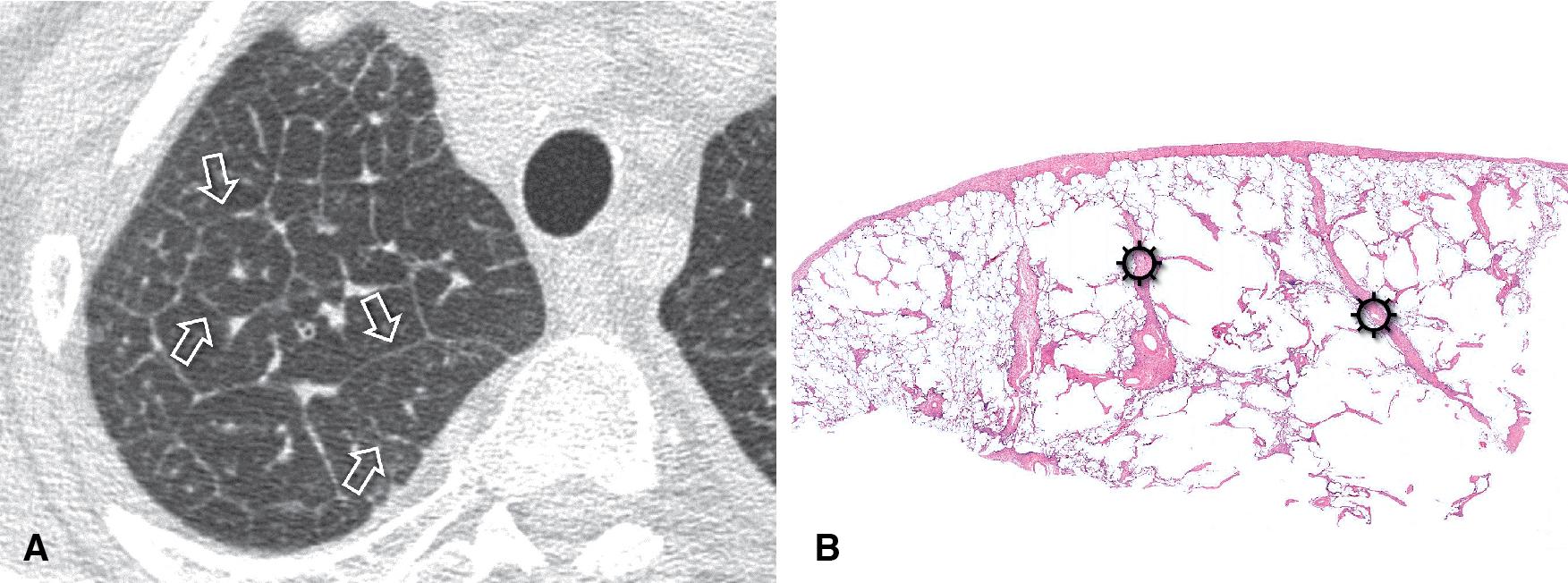
Their shape is variable, depending on the CT plane. Inside the lobules, enlarged arteries and bronchioles with thickened walls are often visible. Smoothly thickened fissures are recognizable ( Fig. 4.22 ), in particular with multiplanar reconstructions. Coexisting patches of faint opacities are possible owing to partial alveolar filling (ground-glass opacity [GGO]). However, these patches do not overshadow the septal aspects; in this case an alveolar pattern should be considered.
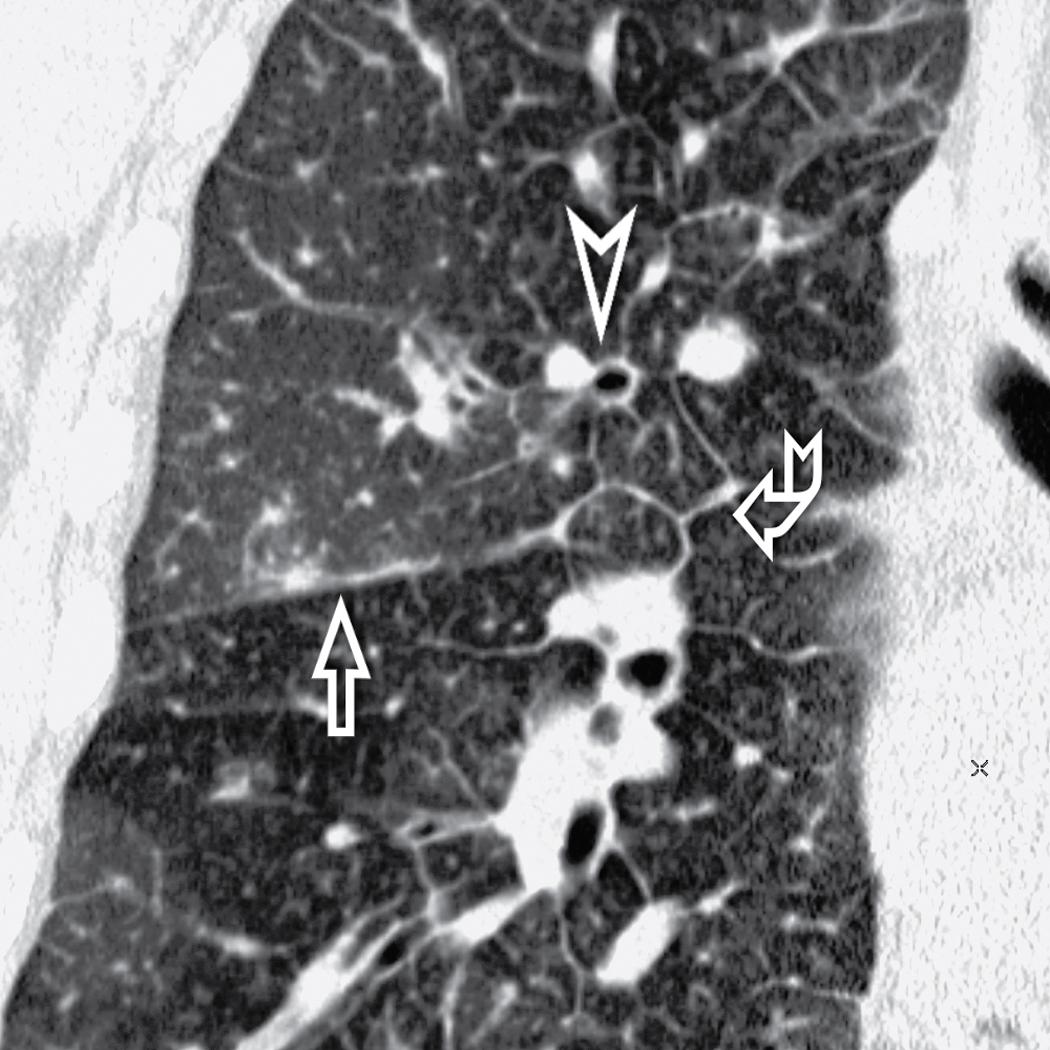
Diseases in the septal pattern, subset smooth, are listed in Box 4.3 .
Interstitial hydrostatic pulmonary edema
Lymphangitic carcinomatosis
Pulmonary venoocclusive disease
Erdheim–Chester disease
Diffuse pulmonary lymphangiomatosis
Congenital pulmonary lymphangiectasia
Acute eosinophilic pneumonia
Amyloidosis
Hemosiderosis
Lymphoproliferative disease
Pulmonary alveolar microlithiasis
The septal lines of pulmonary edema are usually associated with smooth subpleural and peribronchovascular interstitial thickening (peribronchial cuffing). Patchy lobular GGO often coexists because of minimal alveolar edema ( Fig. 4.23 ). There is a tendency for the hydrostatic edema to show a symmetrical basal and posterior distribution (in supine patients) ( Fig. 4.24 ), although patchy nongravitational distributions are not impossible.
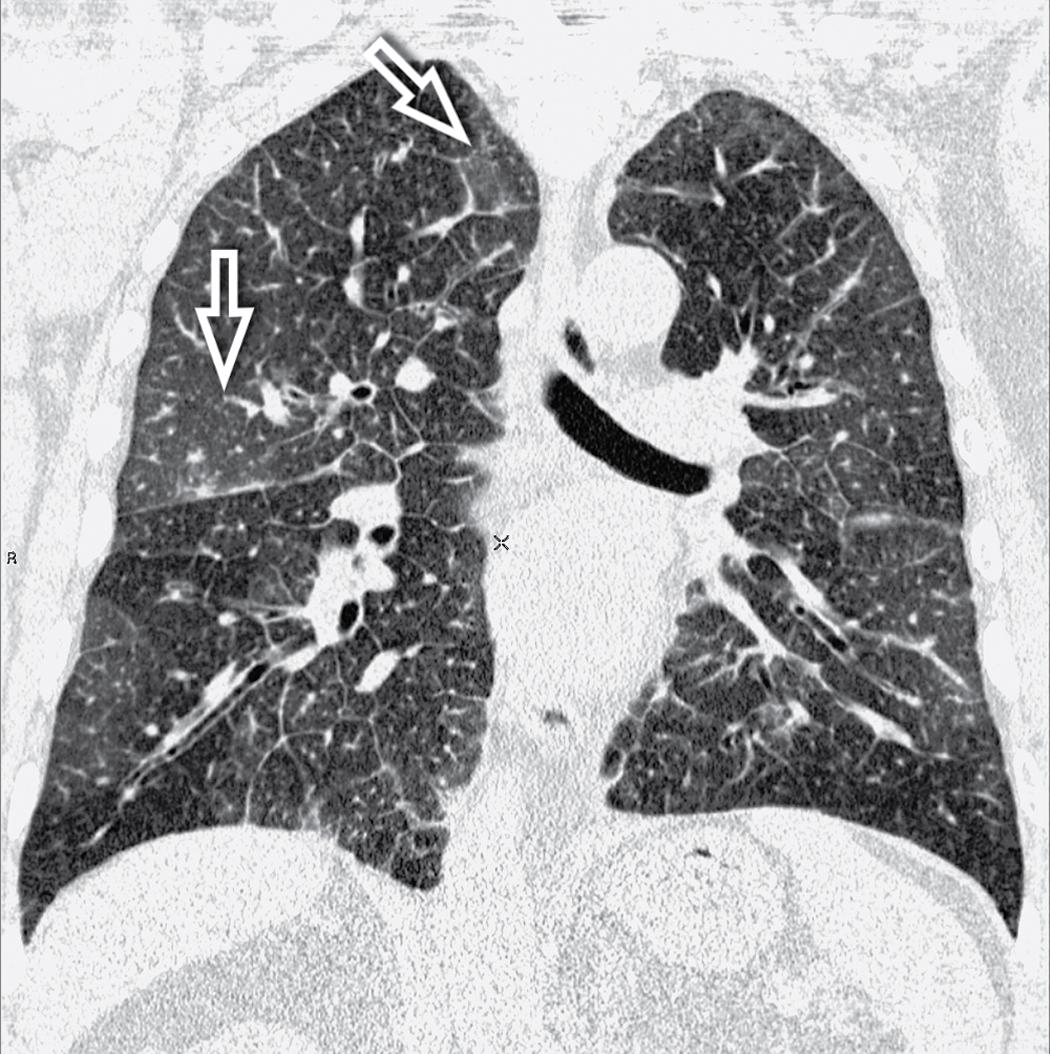
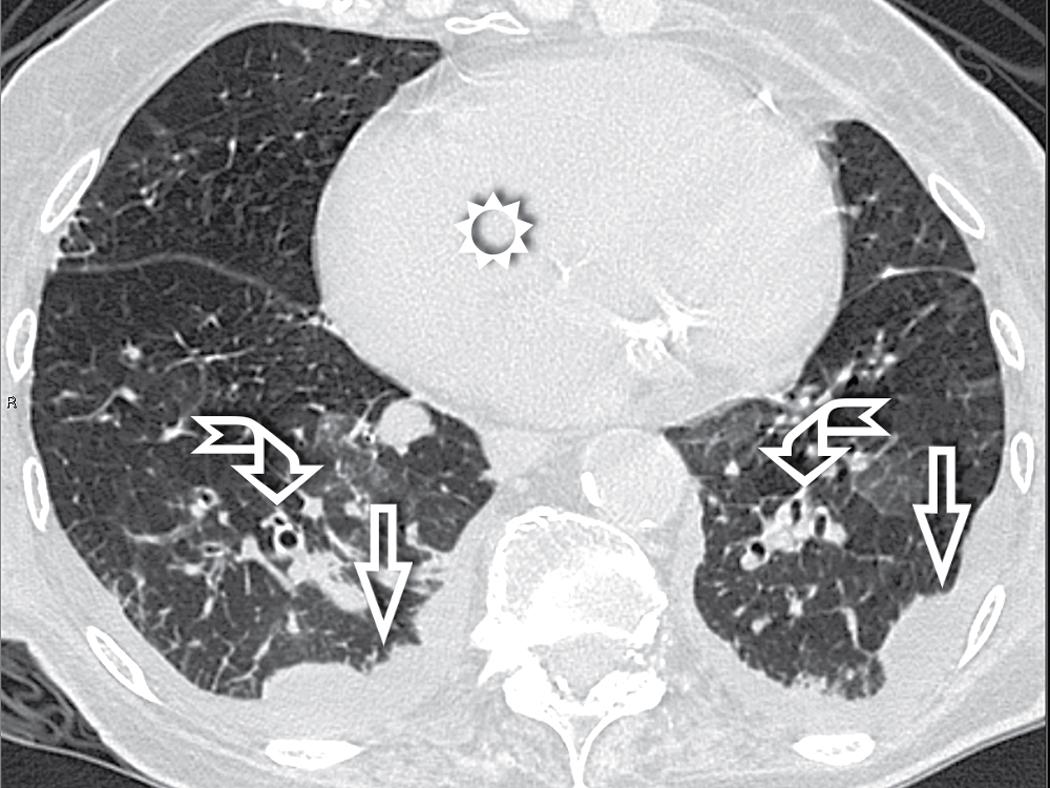
Heart enlargement and bilateral pleural effusion are common findings in cardiogenic pulmonary edema (see Fig. 4.24 ); a pericardial effusion may coexist in a number of patients. When lymph flow to the systemic veins decreases, an enlargement of mediastinal lymph nodes due to fluid stagnation may occur ( Fig. 4.25 ).
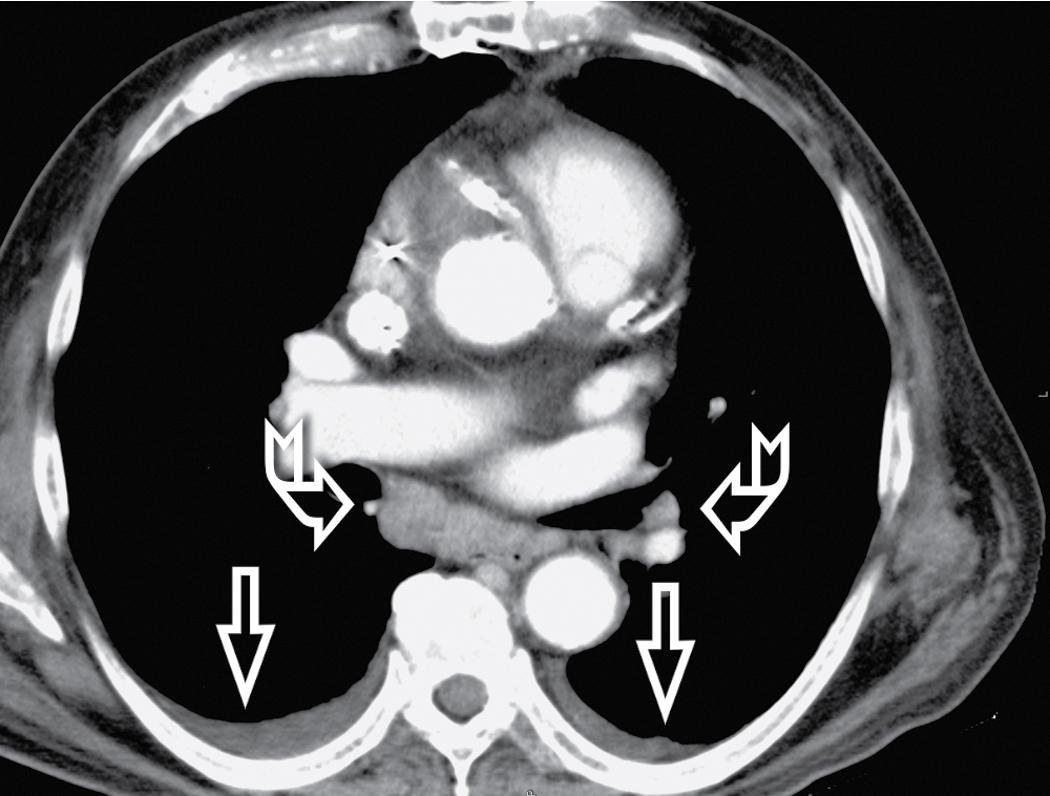
Lymphangitic carcinomatosis (LC) may present with a fully smooth subset ( Fig. 4.26 ), but not infrequently nodular irregularities (beaded appearance of septa and fissures) and random micronodules in areas of thickening do occur. Nodules result from the focal growth of cells within the lymphatics and local extensions into the parenchyma. , Subpleural thickening, when present, may also be smooth or nodular. Pleural effusion is unilateral in 50% of cases.
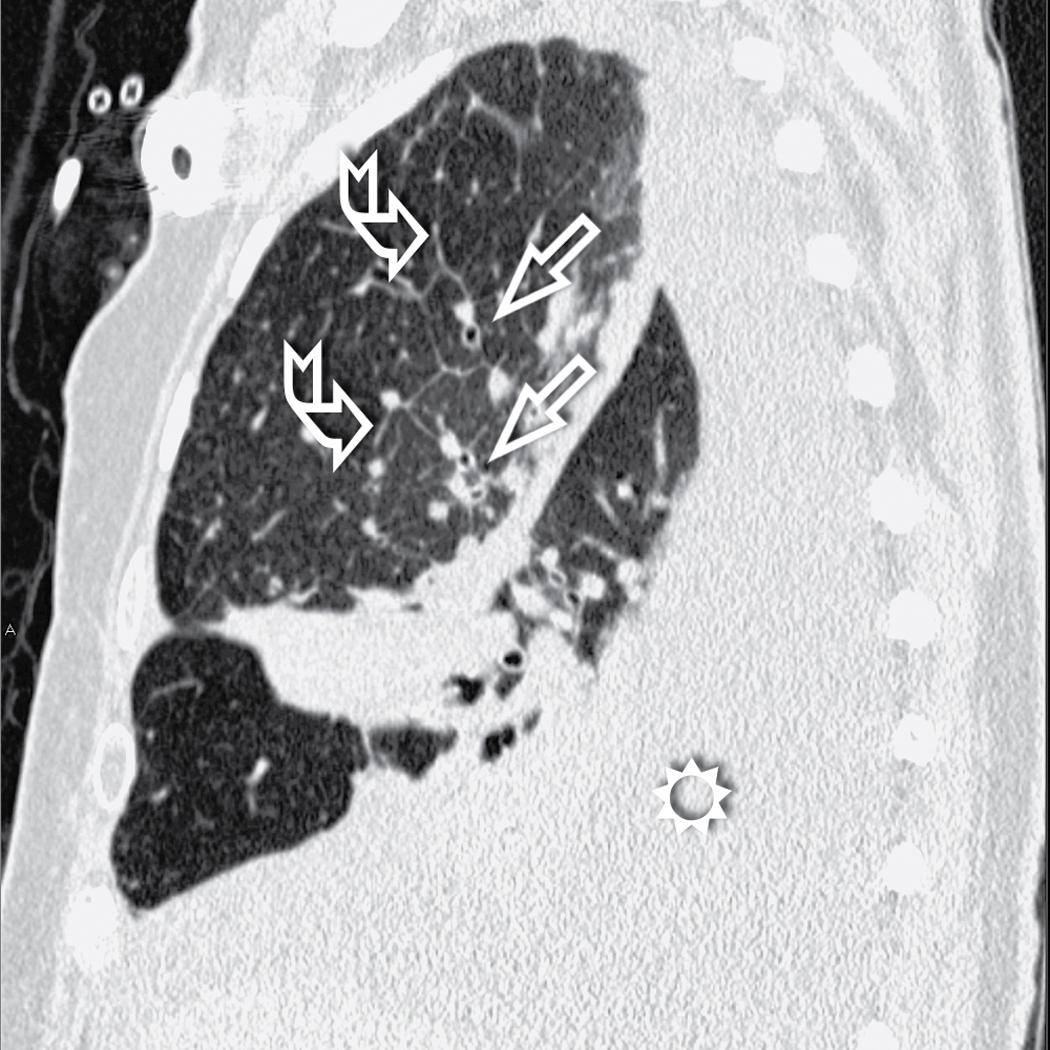
The lesions of LC are typically patchy, often unilateral, and not gravity-dependent ( Fig. 4.27 ). Hilar lymphadenopathy is visible in 50% of patients. Enlarged mediastinal lymph nodes can also be seen in a number of cases (25%–50%). Dedicated CT window settings may demonstrate metastatic lesions elsewhere ( Fig. 4.28 ).
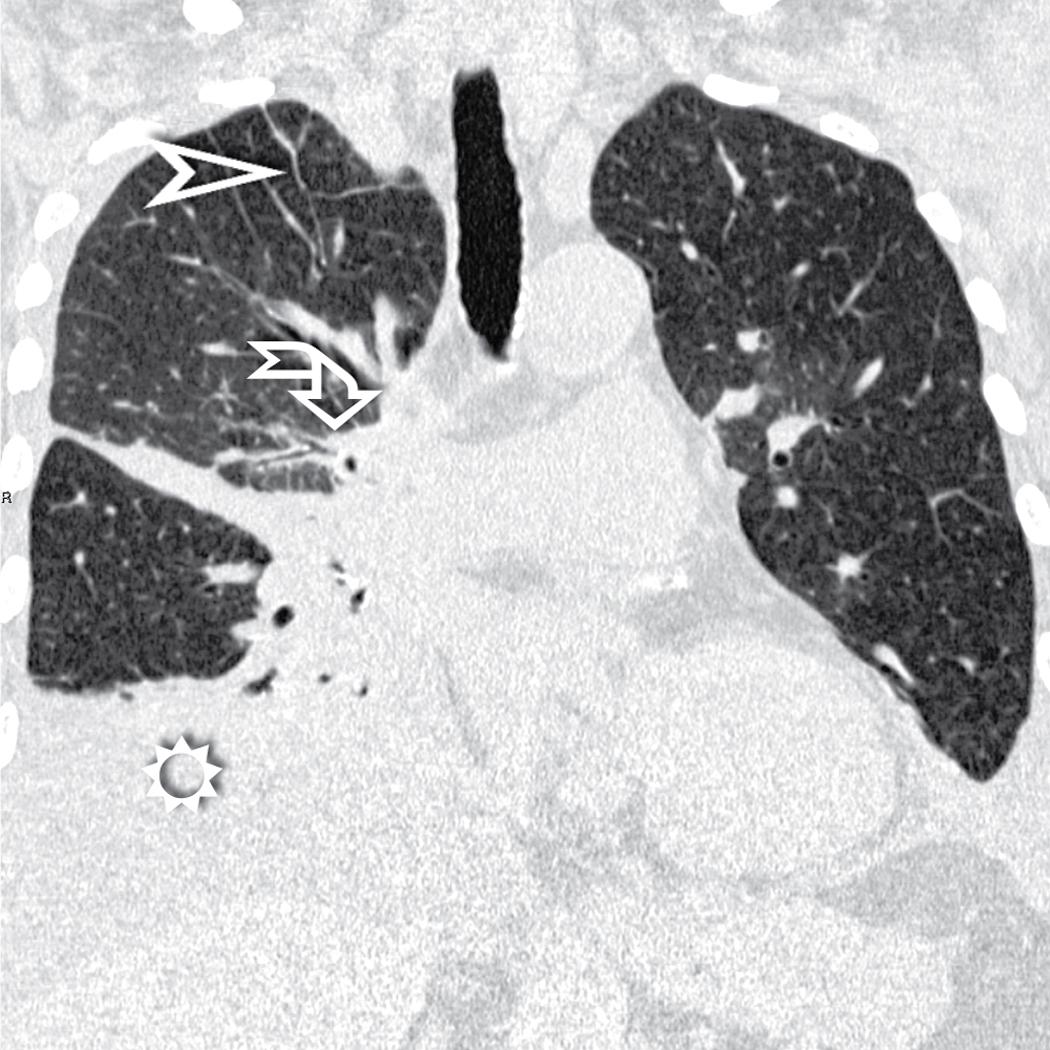
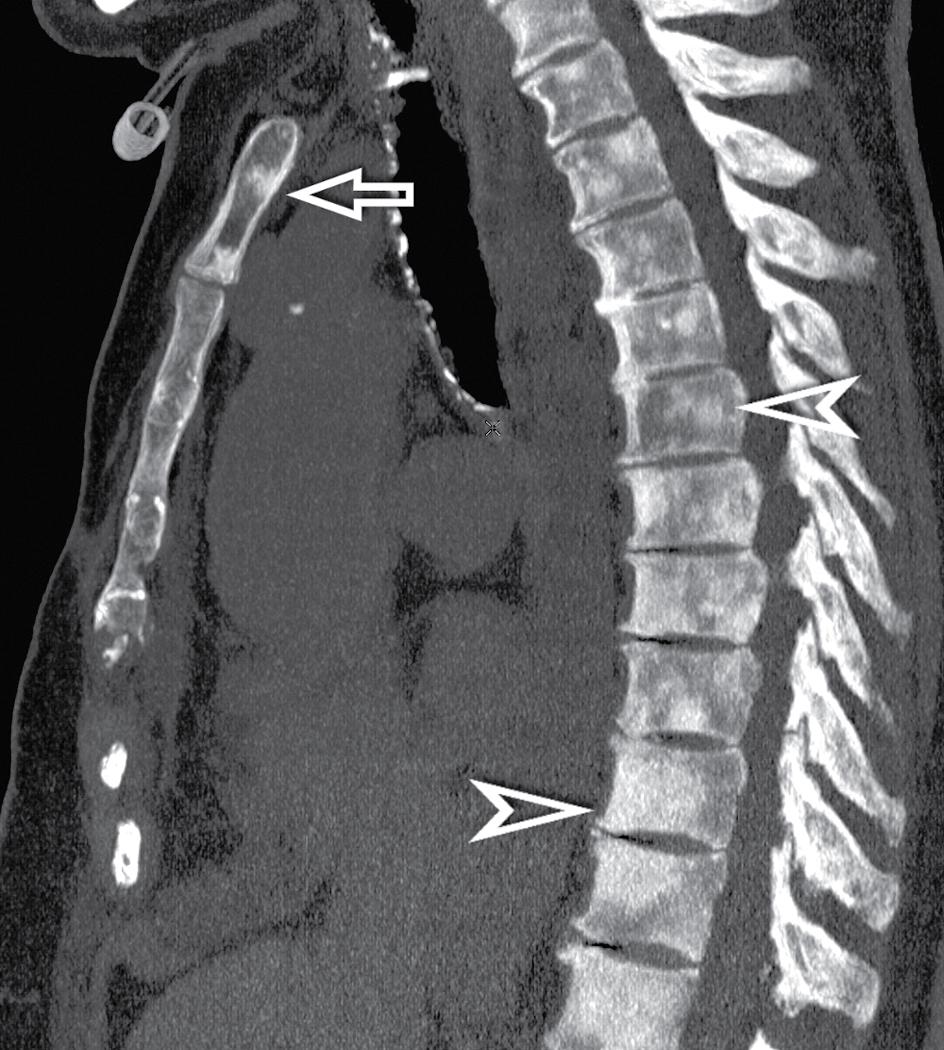
The presentation of venoocclusive disease is similar to that of hydrostatic pulmonary edema. Smooth septal lines, bronchial cuffing, and patches of GGO related to alveolar wall thickening and pulmonary edema are apparent ( Fig. 4.29 ). ,
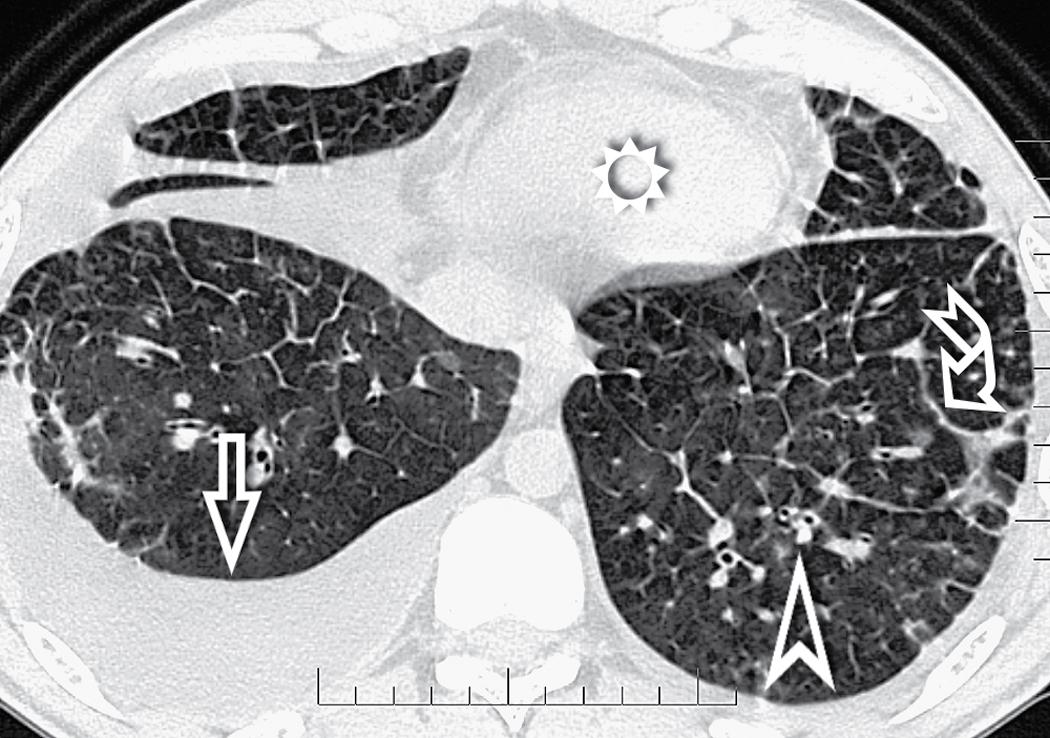
The lesions present a geographical appearance with variable localization. They are always bilateral and may have a gravitational preference ( Fig. 4.30 ).
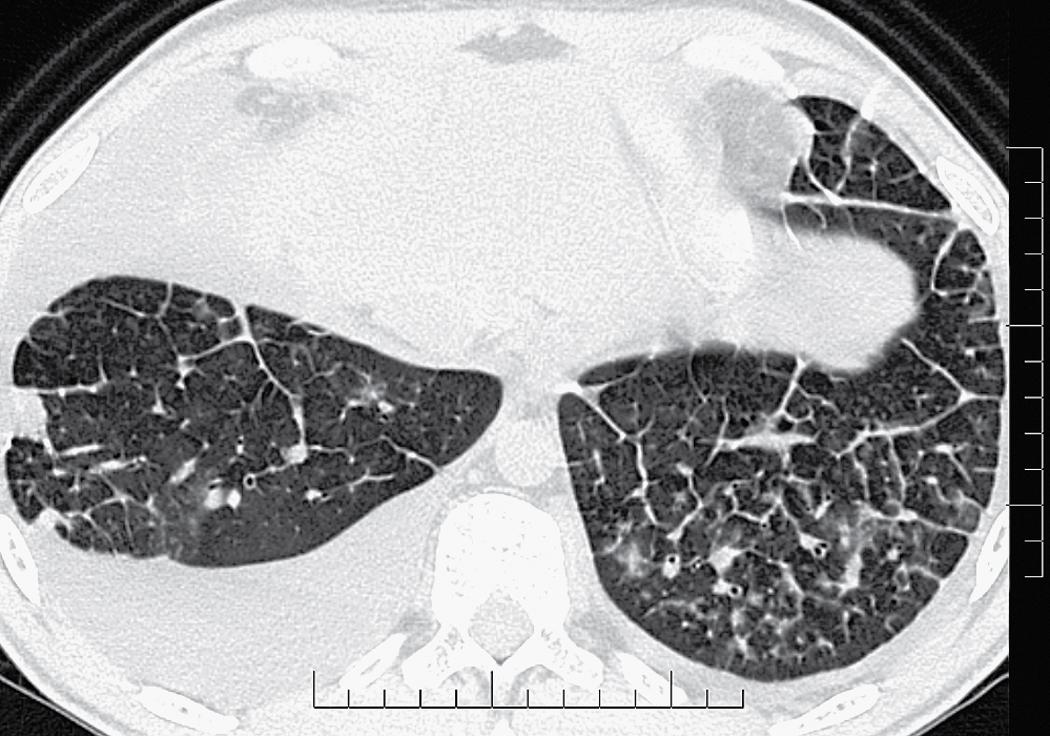
A key radiologic sign is coexisting enlargement of the central pulmonary arteries compatible with arterial pulmonary hypertension ( Fig. 4.31 ). The right side of the heart may also be dilated without evidence of left atrial or ventricular enlargement. In addition, pericardial or pleural effusion and enlargement of the mediastinal lymph nodes may be visible.
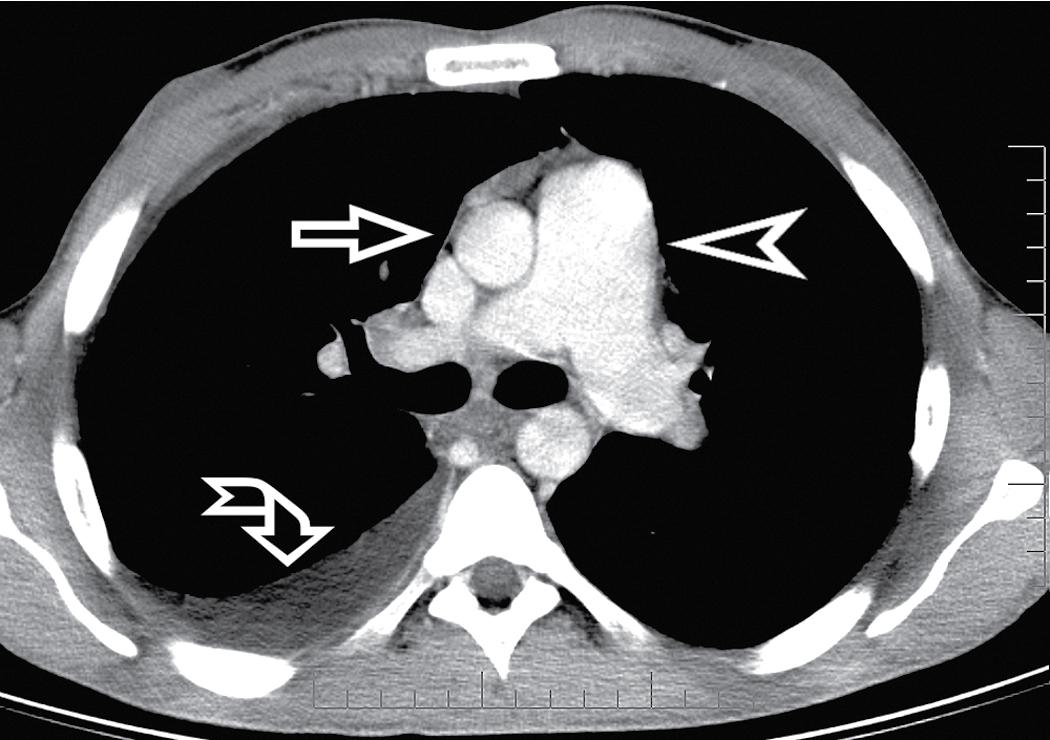
Erdheim-Chester disease (ECD) is a nonLangerhans cell systemic histiocytosis that produces smooth septal and subpleural interstitial thickening with more or less regular contours ( Fig. 4.32 ). Multifocal areas of ground-glass attenuation, small centrilobular nodular opacities, and pleural effusion may be also present. ,
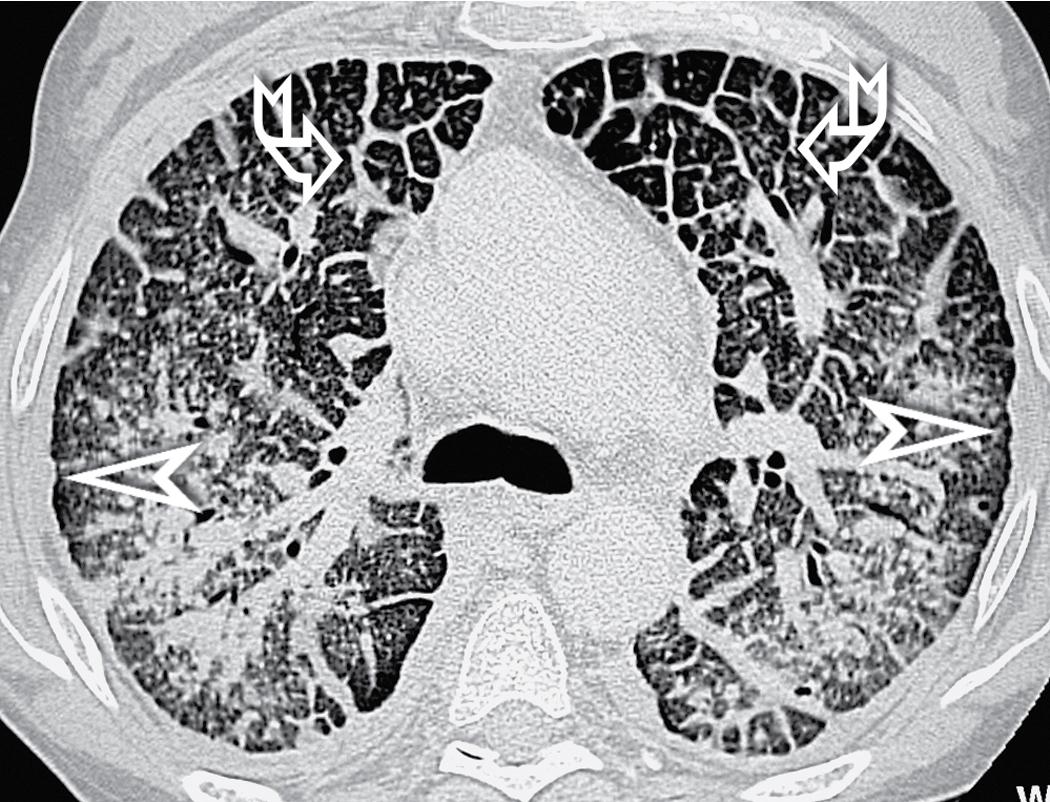
The septal lesions of ECD involve both lungs diffusely ( Fig. 4.33 ), but in some cases they may predominate in the upper or lower lobes. In addition, the pleura and mediastinal structures may be involved ( Fig. 4.34 ). The superior vena cava, along with the pulmonary trunk and main arteries, may be coated by anomalous tissue; in case of severe involvement, a reduction of the vascular lumen is also possible. The cardiac involvement may be endocardial or myocardial (not visible with high-resolution computed tomography [HRCT]) or pericardial, the latter being the most frequent and most clearly visible on images, thanks to the contrast provided by the adjacent pericardial fat (see Fig. 4.34 ).
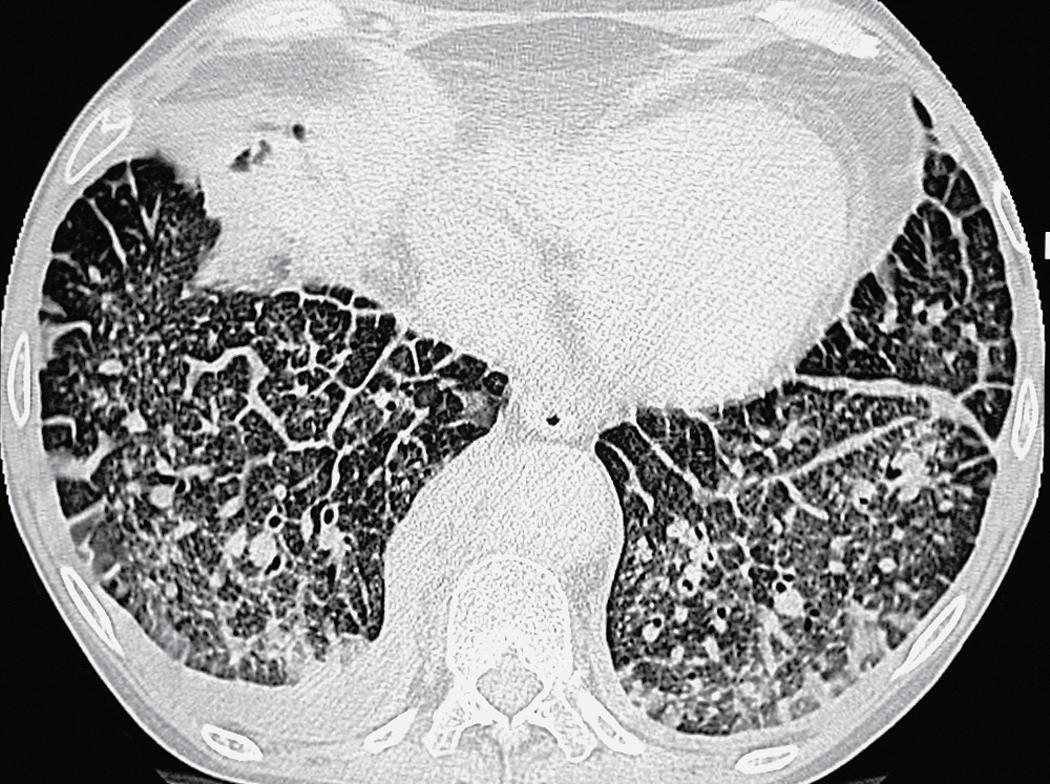
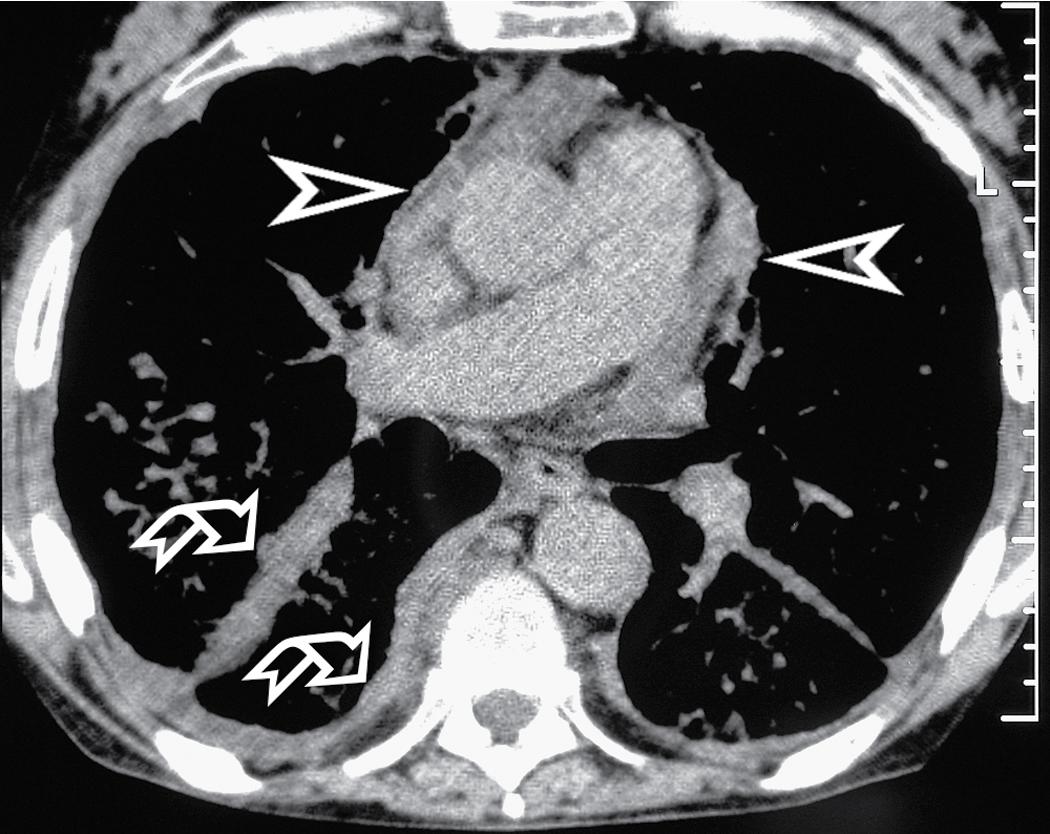
In addition, easily appreciable and frequently associated features can contribute to the diagnosis, consisting in a sclerotic lesion of long bones, mainly tibia and femur and along their anterior aspect.
The interstitial compartments are thickened in nodular form, testifying to the existence of locally growing cells or extracellular deposits within the interstitial boundaries ( Fig. 4.35 ). , , Being interstitial, these nodules are dense with well-defined margins ( Fig. 4.36 ), embedded as they are inside thickened interlobular septa and interstitial lines with an overall beaded appearance.
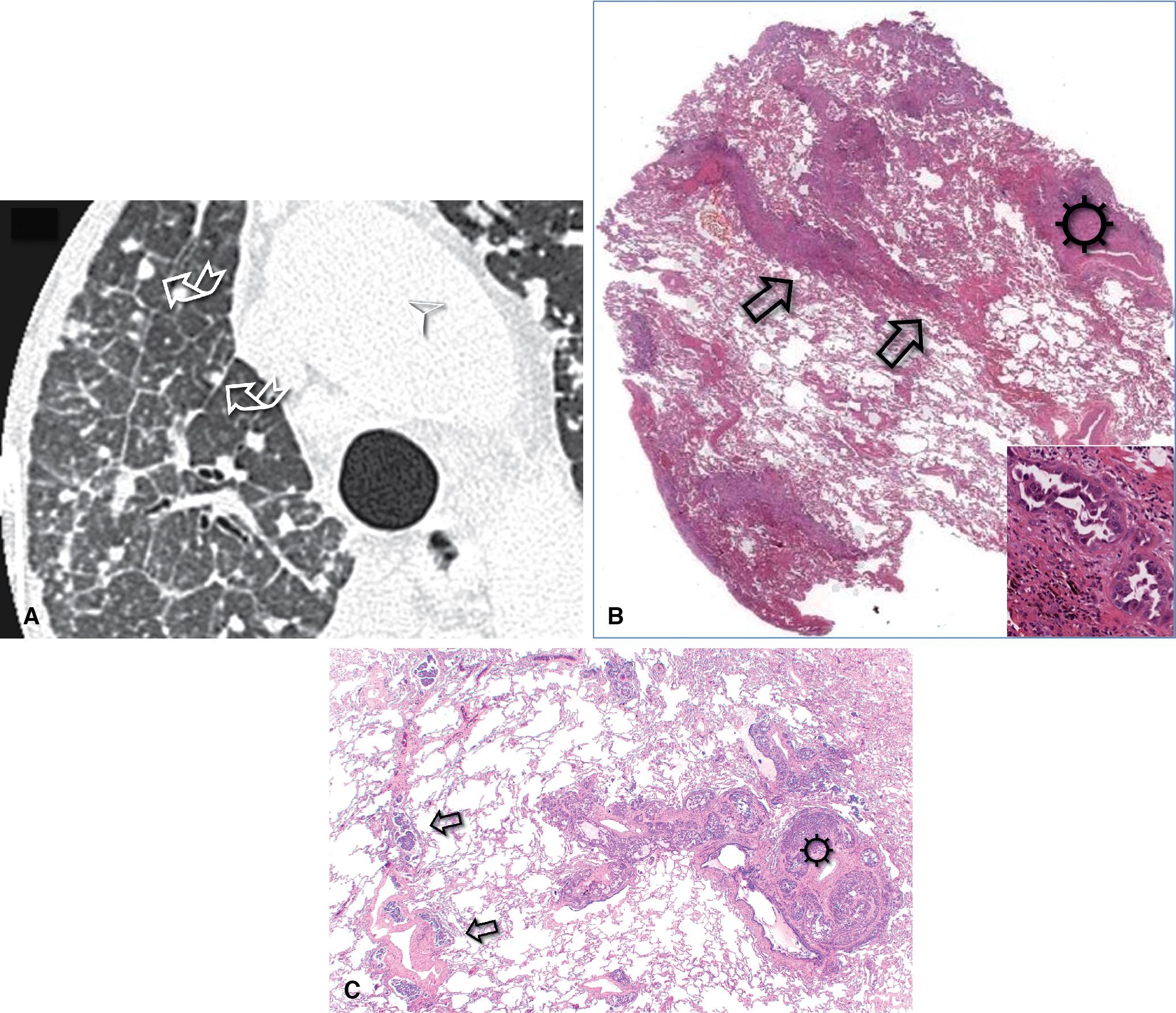
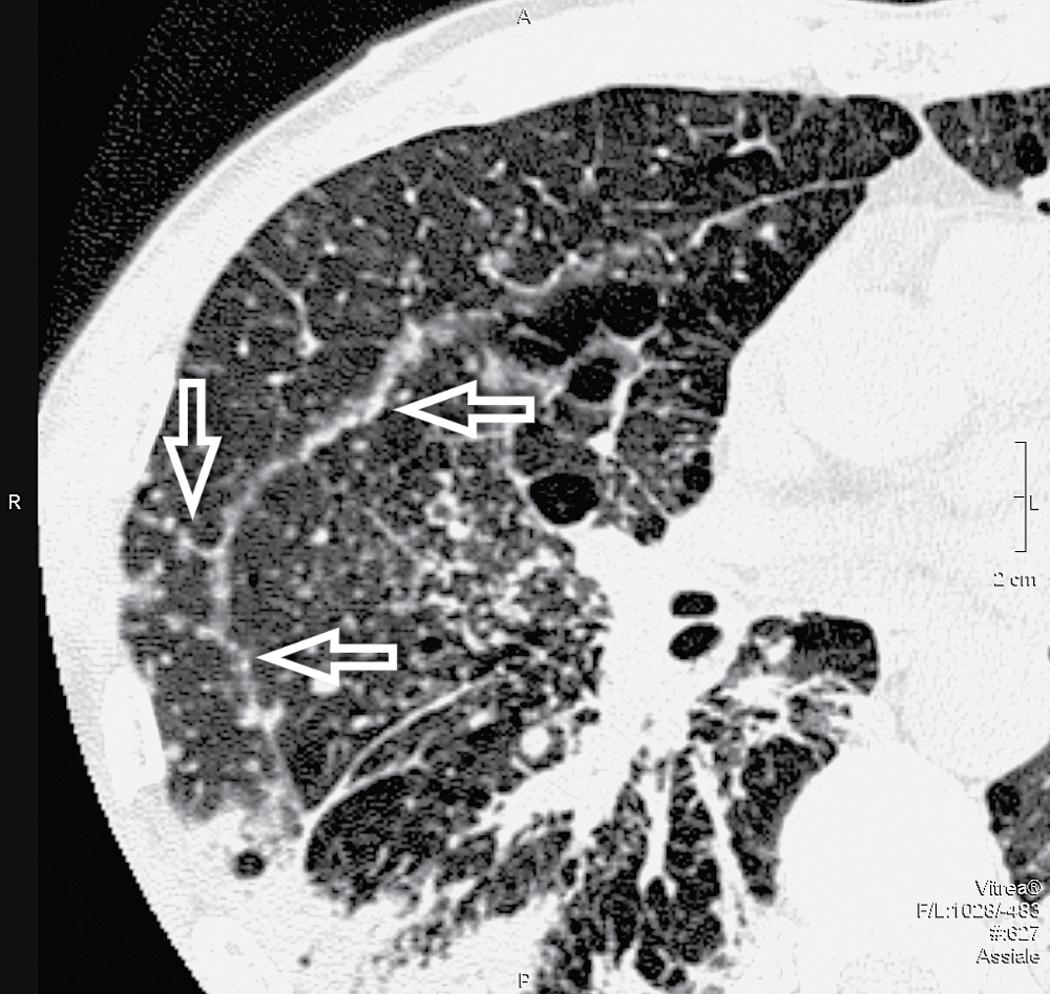
The septal pattern, subset nodular, differs from the nodular pattern, subset lymphatic, where the nodules are more or less individually seen along appropriate routes that are not thickened. This important distinction helps the radiologist to distinguish between the two diseases (e.g., LC [septal pattern, subset nodular] from sarcoidosis [nodular pattern, subset lymphatic]).
Lymphoid interstitial pneumonia (LIP) is a multifaceted disease that may present with different patterns, including cystic, nodular, and septal. However, it more often tends to show nodules along lymphatic routes, so it has been placed in the nodular pattern, subset lymphatic.
Diseases in the septal pattern, subset nodular, are listed in Box 4.4 .
The diffuse interstitial form of amyloidosis is characterized by smooth or nodular septal, peribronchovascular, and subpleural thickening, frequently (50%) associated with well-defined subpleural nodules that are often calcified ( Fig. 4.37 ). , The lesions of diffuse pulmonary amyloidosis show a basal and peripheral prevalence ( Fig. 4.38 ).

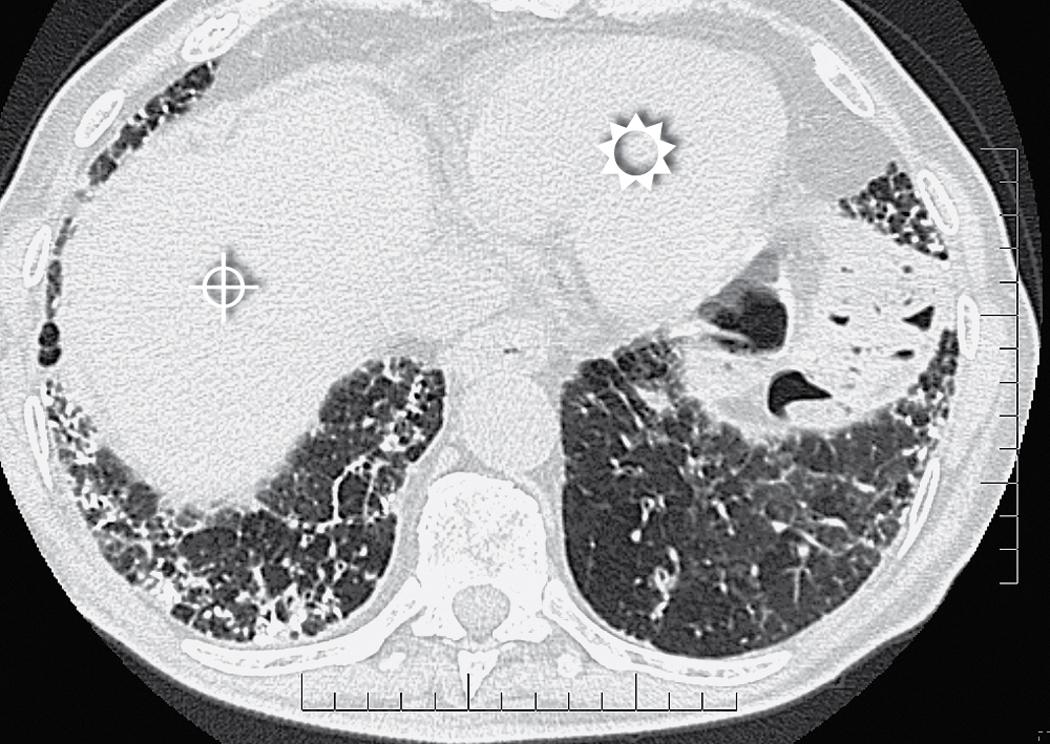
The key to the diagnosis is the existence of subpleural, confluent, calcified consolidations ( Fig. 4.39 ). Associated findings are lymph node enlargement and unilateral or bilateral pleural effusions. Tracheobronchial involvement may also be present, with thickening of the tracheal and bronchial walls due to the deposition of amyloid. In cardiac magnetic resonance (MR) imaging, the left ventricular wall is typically thickened, with associated diastolic dysfunction. Delayed contrast material–enhanced cardiac MR imaging typically shows global transmural or subendocardial enhancement.
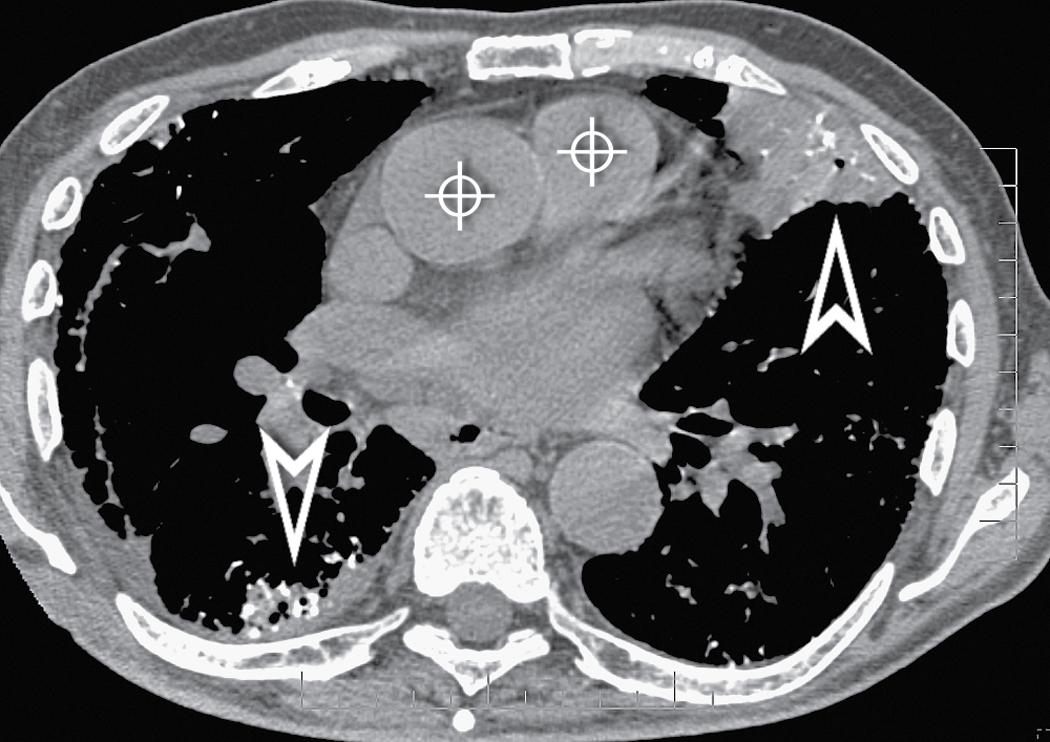
A fibrotic pattern is present when signs of retraction and remodeling of thoracic structures are recognizable at the lobular level and/or in corresponding larger portions of the lung ( Fig. 4.40 ).
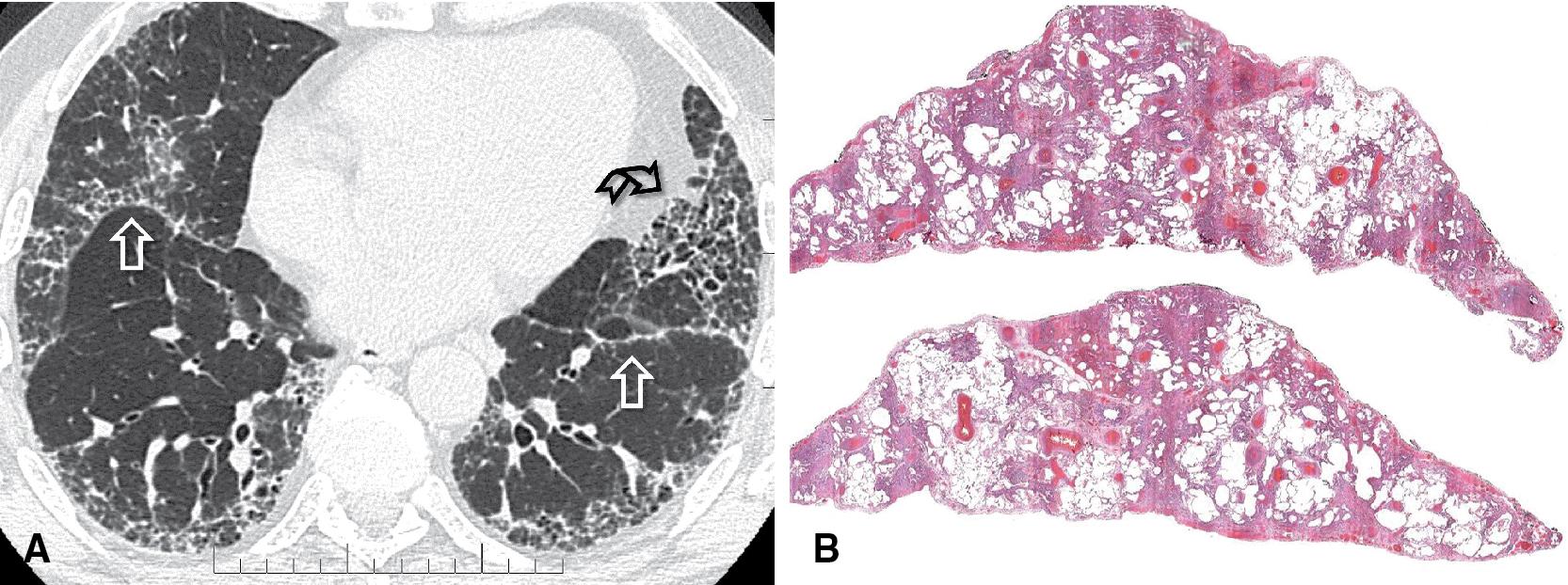
The signs of fibrotic disease are associated with the direct visualization of fibrotic elements or with the effects of retraction and remodeling on pulmonary structures. Direct signs of fibrosis are irregular linear opacities (irregular reticulation), vessel enlargement, traction bronchiectases, and bronchiolectases with bronchial wall thickening, parenchymal bands, and honeycombing. The effects of lung retraction and remodeling are identifiable as irregular displacement of fissures, crowding of vessels, and retraction of the pleural/mediastinal surfaces with interface signs. These features are all due to shrinking of the pulmonary parenchyma with volume loss.
Irregular linear opacities (irregular reticulation) are crisscrossing, nonuniform, wavering white lines which appear as though they had been traced by an unsteady hand on the lung background ( Fig. 4.41 ). They might occasionally represent remnants of interlobular septa (interlobular reticulation), but as rule interlobular septa are not seen. On the contrary, distortion due to fibrosis tends to hamper the recognition of lobular architecture. Most of these lines crisscross the lobular frame, so they are also called intralobular reticulation (see Fig. 4.41 ).
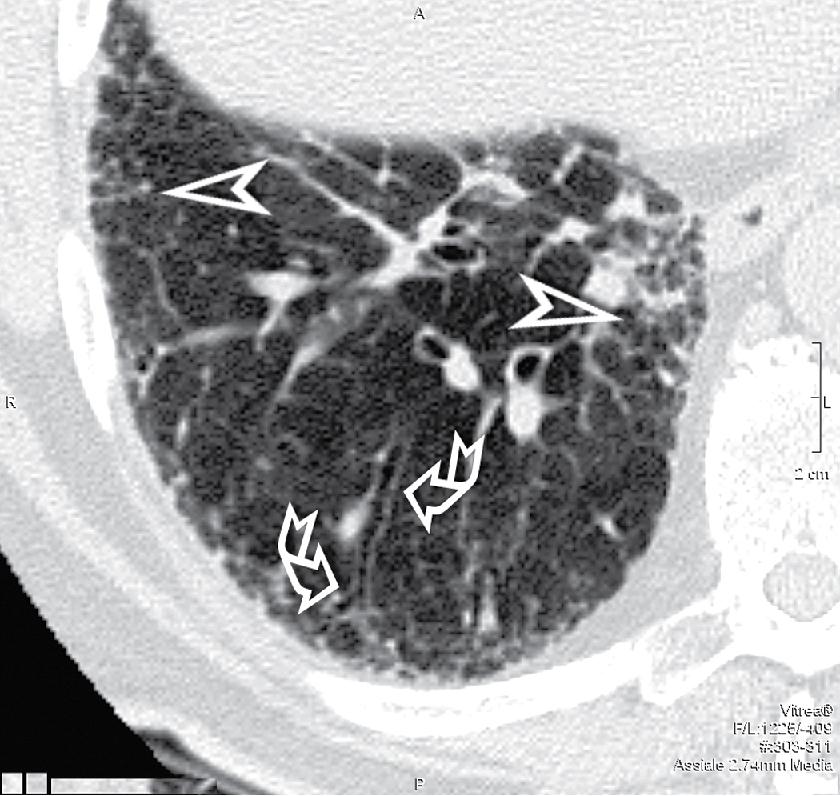
The vessels may appear enlarged, with shaggy margins ( interface sign), and the bronchi are irregularly ectatic with thickened walls and a winding or corkscrew appearance ( Fig. 4.42 ). At the periphery of the lung, the bronchioles may also be ectatic (and hence visible) with the same appearance (traction bronchiectases and bronchiolectases) (see Fig. 4.41 ). Finally, parenchymal bands are long lines representing thickened connected septa at the margins of several lobules but also focal scarring or linear atelectasis.
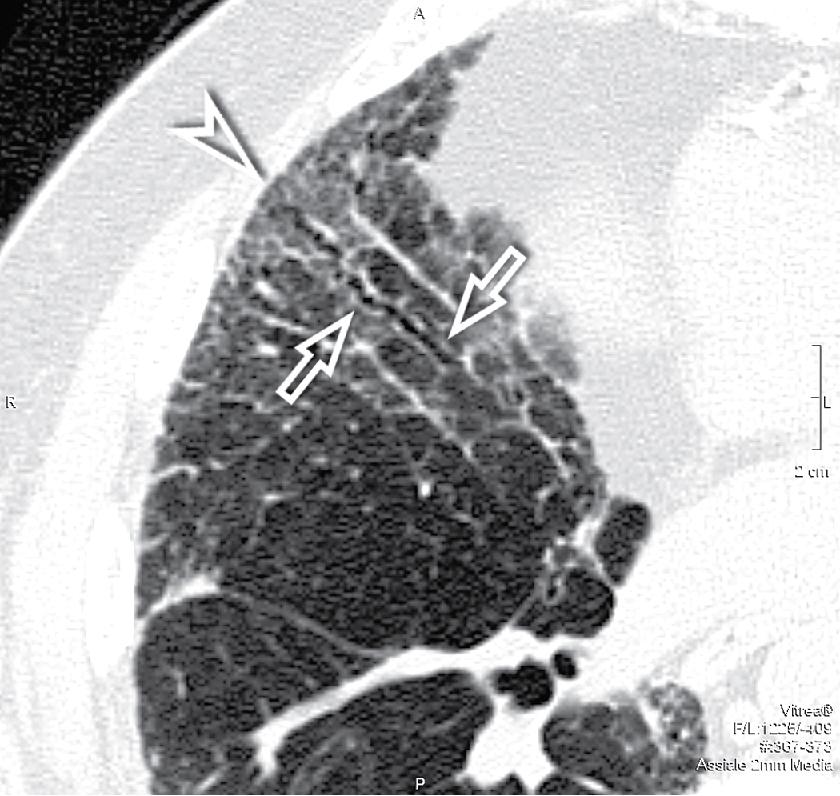
As a whole, the described lesions may vary in size and morphologic details, from a more or less coarse, obviously fibrotic pattern to a subtle, hazy opacification of the lung, referred to as fibrotic GGO , which is only minimally inhomogeneous. In the latter case, ectatic bronchioles inside the GGO and superimposing irregular reticulation (indicating fibrosis) are the discriminant features (see Fig. 4.42 ).
A peculiar feature of destructive fibrosis is honeycombing. In honeycombing, small hyperlucent areas of variable size (from 2 mm to 1 cm) and shape separated by well-defined thick walls are crowded in an area where the lung architecture is lost ( Fig. 4.43 ). They should be distinguished (not easy and not always possible, especially in the early cases) from roundish or elongated, windingly linear, transparencies corresponding to ectatic bronchioles.
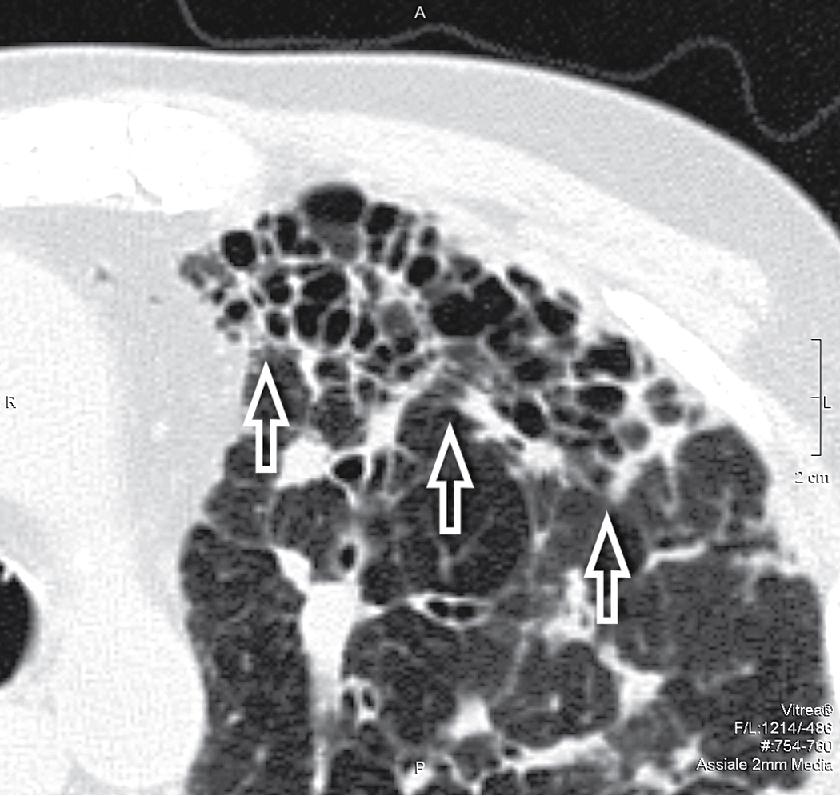
Signs of retraction and remodeling give further, at times striking, evidence of the existence of a fibrotic disorder. At the pulmonary interface, a pleural line with shaggy margins and connections with parenchymal irregular lines (interface signs) may be evident ( Fig. 4.44 ). A thickening of the subpleural interstitium may also be obvious, as well as an increased thickness of extrapleural/mediastinal fat, the latter compensating for the shrinking lung (see Fig. 4.44 ). A shaggy thickening may also be observed at the interface of the visceral pleura, which becomes angulated and displaced.
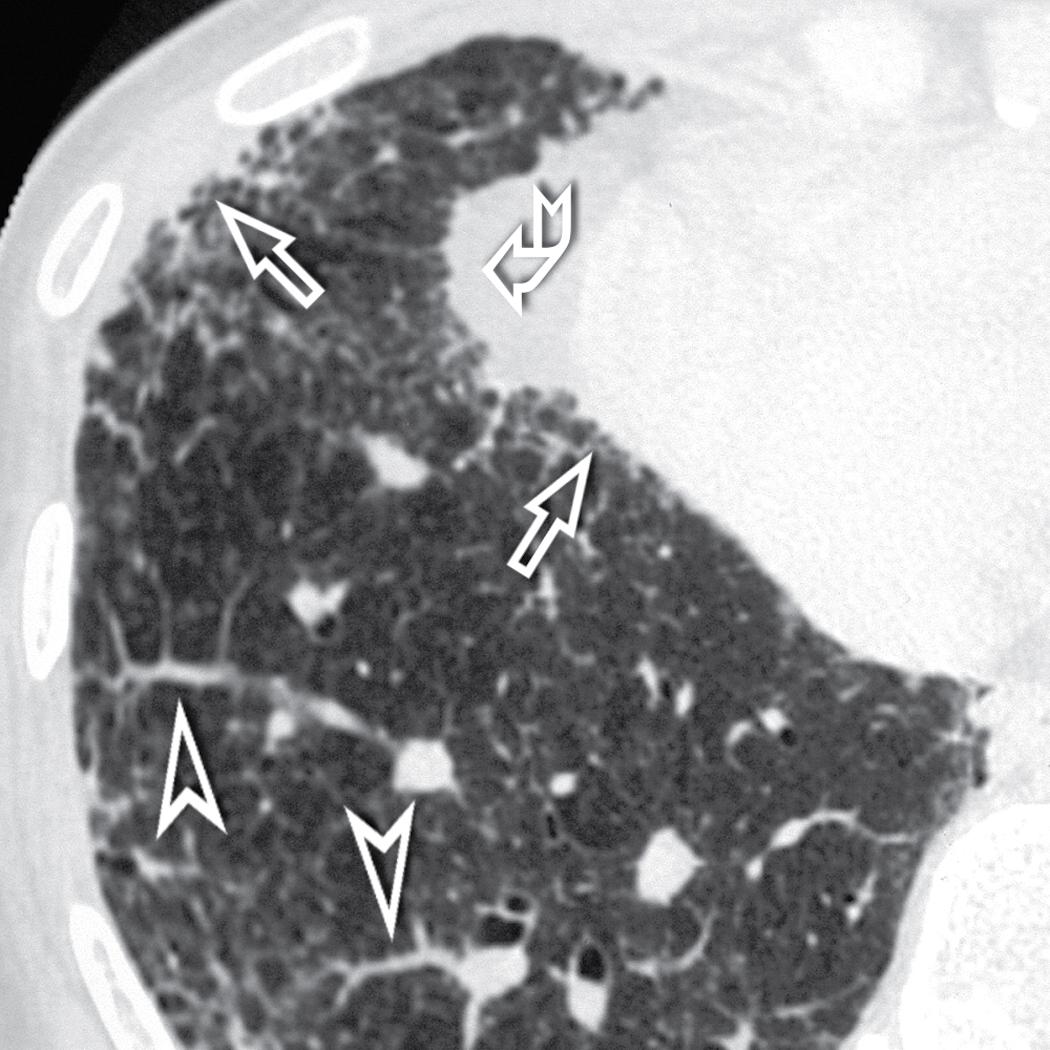
When fibrosis advances, one or more lobes and even the entire lung may eventually become reduced in size. The signs associated with this evolution are angulation and displacement of fissures, crowding of vessels and bronchi, and mediastinal and diaphragmatic attraction toward the affected lung ( Fig. 4.45 ).
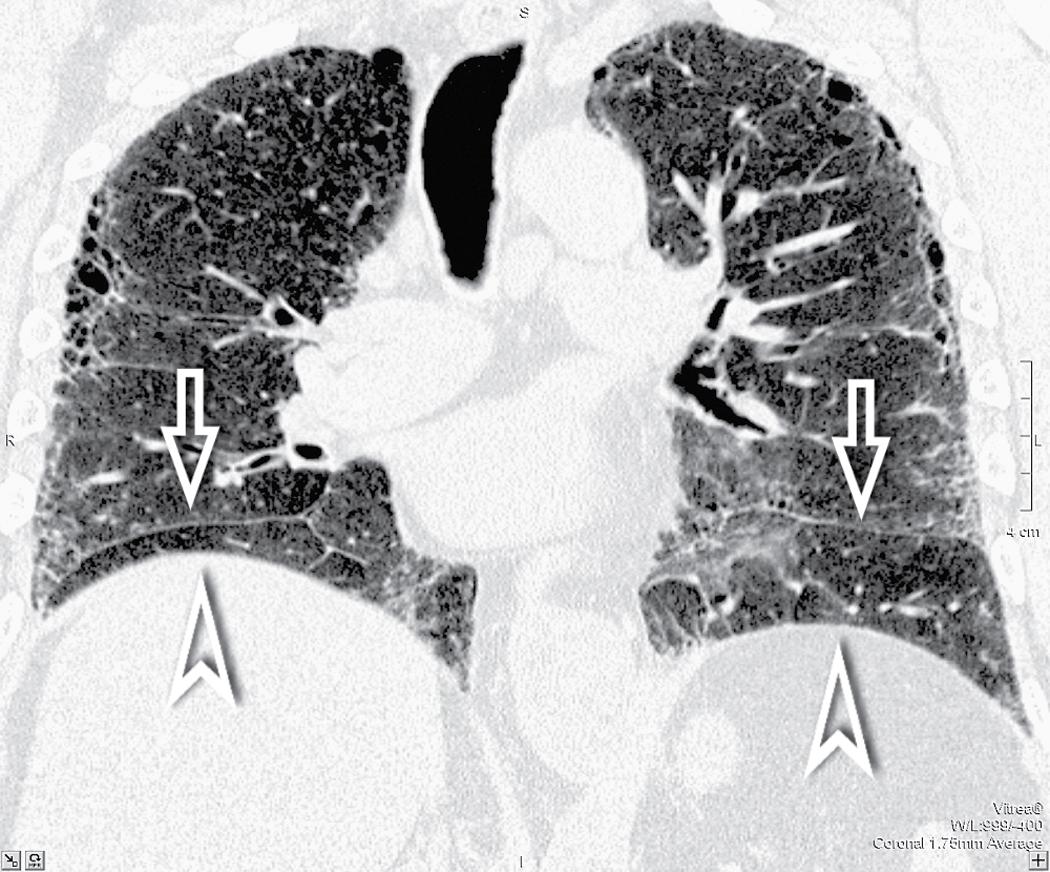
Depending on the underlying disease, the morphologic elements and their topographic distribution may be arranged in subsets that are helpful in defining specific categories of fibrotic disorders and at times even specific diseases. The main subsets of the fibrotic pattern are usual interstitial pneumonia (UIP), nonspecific interstitial pneumonia (NSIP), and tug-of-war fibrosis.
The UIP subset is defined by the presence of patchy areas of irregular reticulation and patchy honeycombing with prominent signs of architectural distortion ( Fig. 4.46 ). Traction bronchiectases and microscopic honeycombing associated with the pathologic areas are also characteristic. Some GGO is possible, but it would be less extensive than the reticulation. Signs of retraction and remodeling of vessels, fissures, lobes, and pulmonary boundaries are common, especially in advanced cases ( Fig. 4.47 ).
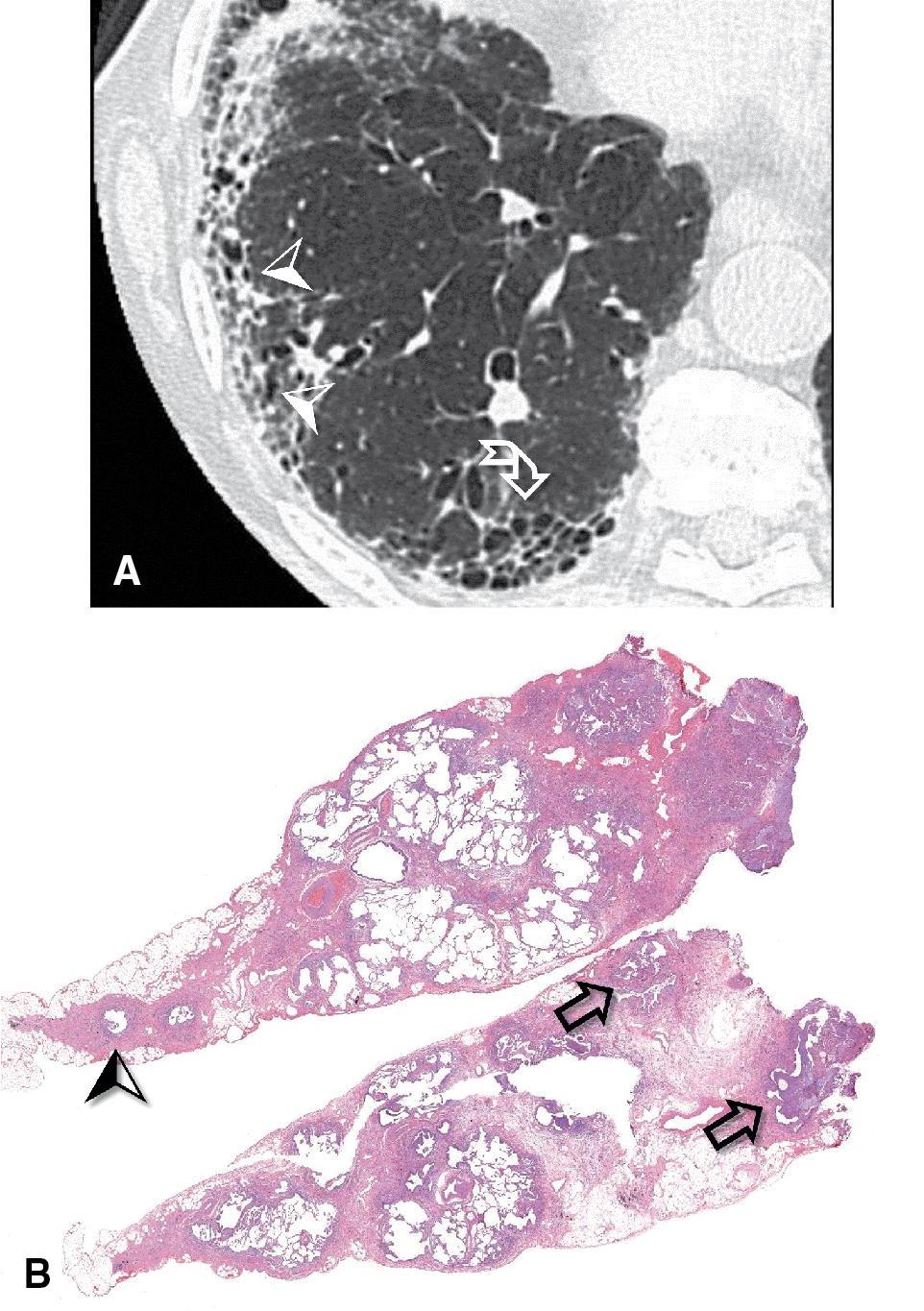
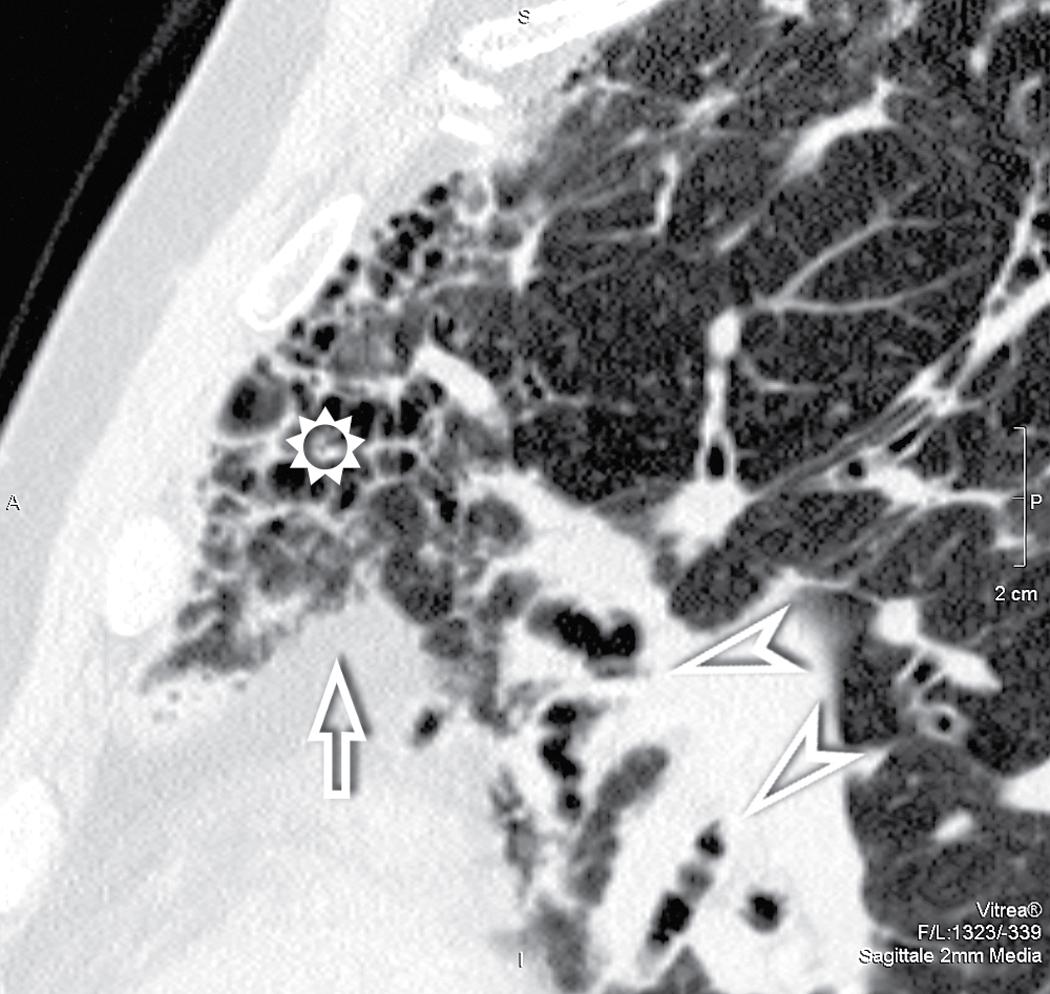
The UIP subset may be seen both in IPF and, with identical features, in several collagen vascular diseases (CVDs) as well as chronic hypersensitivity pneumonitis (HP) and, more rarely, in asbestosis and chronic drug toxicity. The elementary lesions of UIP are also present in the background in individuals who develop an acute clinical course (acute exacerbation or acceleration of IPF), where the histologic findings show superimposed features of acute lung injury; which usually dominate the radiologic presentation. This is therefore discussed under in the section Alveolar Pattern, subset Acute. Diseases in the fibrotic pattern, subset UIP, are listed in Box 4.5 .
Idiopathic UIP (clinical idiopathic pulmonary fibrosis [IPF])
Collagen vascular diseases (CVD) (see Idiopathic UIP)
Chronic hypersensitivity pneumonitis (HP) (see also Box 4.6 )
Asbestosis
Chronic drug toxicity (see Idiopathic UIP)
Accelerated usual interstitial pneumonia (UIP) and HP (see Alveolar Pattern, subset Acute)
The early lesions of this disease are a combination of centrilobular dotlike and branching opacities, which are often arranged in clusters or connected by subpleural curvilinear lines ( Fig. 4.48 ). These nodular opacities correspond to peribronchiolar nodular fibrosis, which is also responsible for hyperlucent areas (mosaic perfusion) of lobular size from air trapping. The subsequent evolution may lead to an irregular interlobular and intralobular reticulation with bronchiectasis, architectural distortion, and honeycombing.
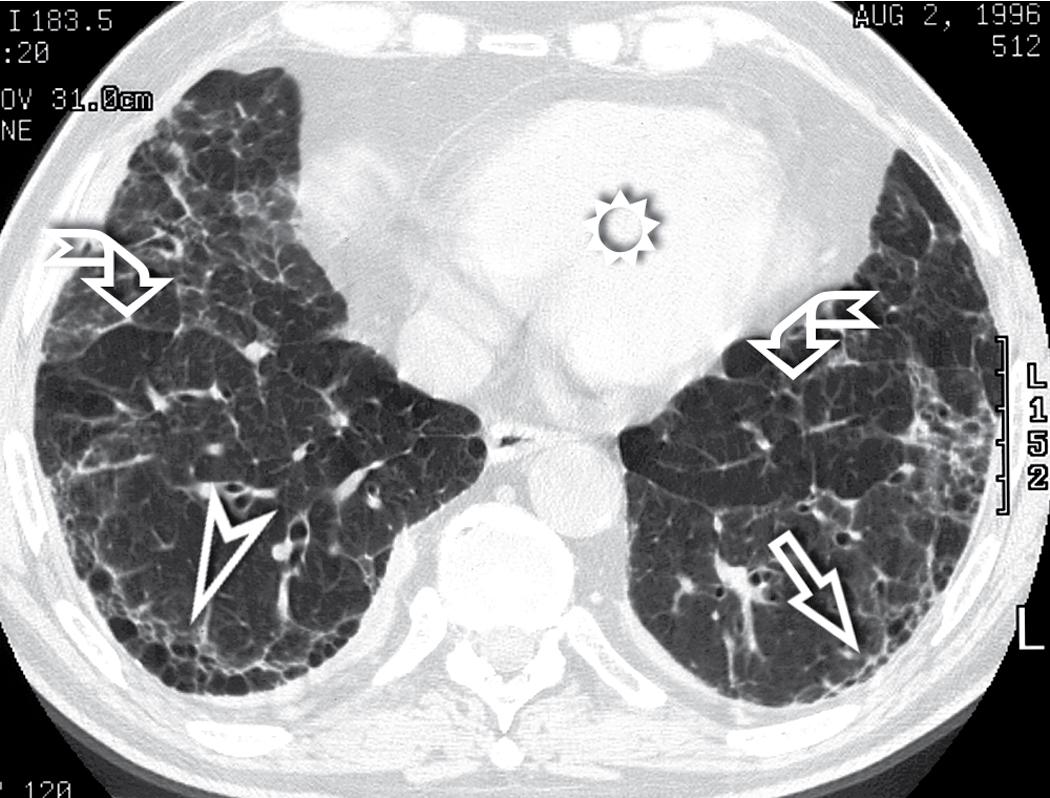
The lesions are predominantly or exclusively located in the subpleural lobules of the posterior regions of the lower lobes and anteriorly in upper lobes (helical course) in the early phases of disease ( Fig. 4.49 ), but they may become more extensive as the disease progresses.
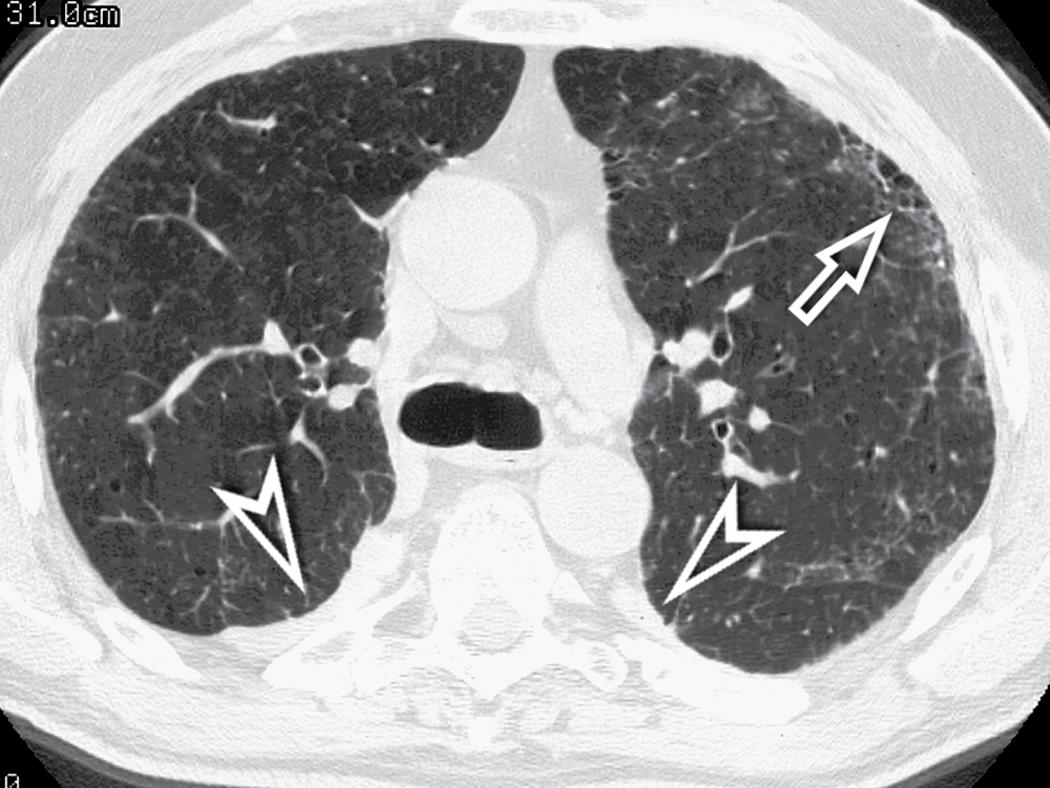
Diffuse parietal pleural thickening and pleural plaques with or without calcifications ( Fig. 4.50 ; see also Figs. 4.48 and 4.49 ) are considered typical of the asbestos-related disease, but not all patients with asbestosis show pleural abnormalities. Parenchymal bands are also characteristic of this disease (see Fig. 4.50 ) and may reflect thickening of interlobular septa, fibrosis along bronchovascular sheaths, coarse scars, or areas of atelectasis adjacent to pleural plaques or visceral pleural thickening. ,
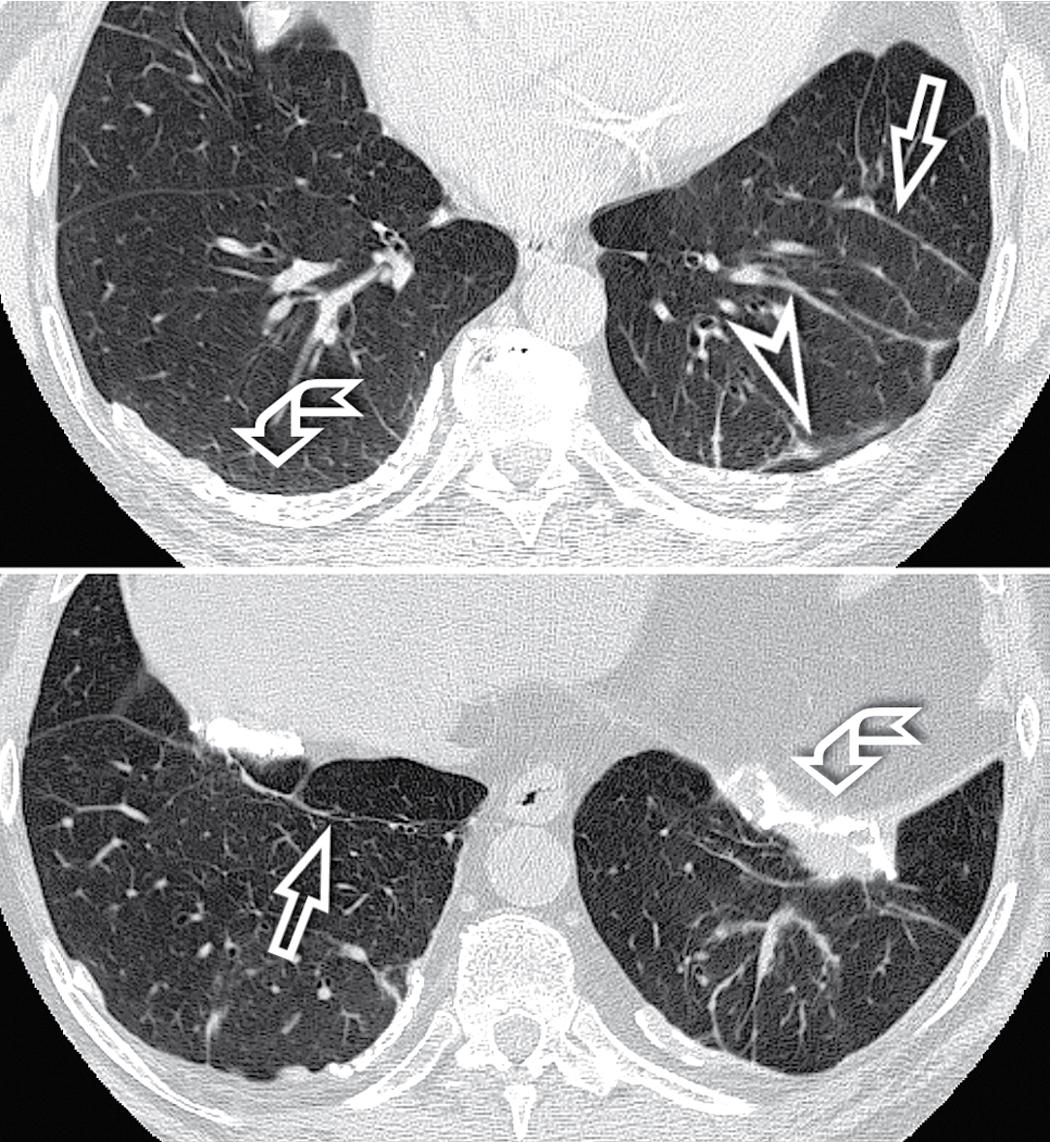
According to the new guidelines of diagnosis of fibrotic HP, on CT the “typical HP” pattern suggestive of a diagnosis of HP requires an HRCT pattern of lung fibrosis and at least one abnormality that is indicative of small airway disease ( Fig. 4.51 ). The distribution of fibrosis may be: random both axially and craniocaudally or mid lung zone–predominant or relatively spared in the lower lung zones ( Fig. 4.52 ).
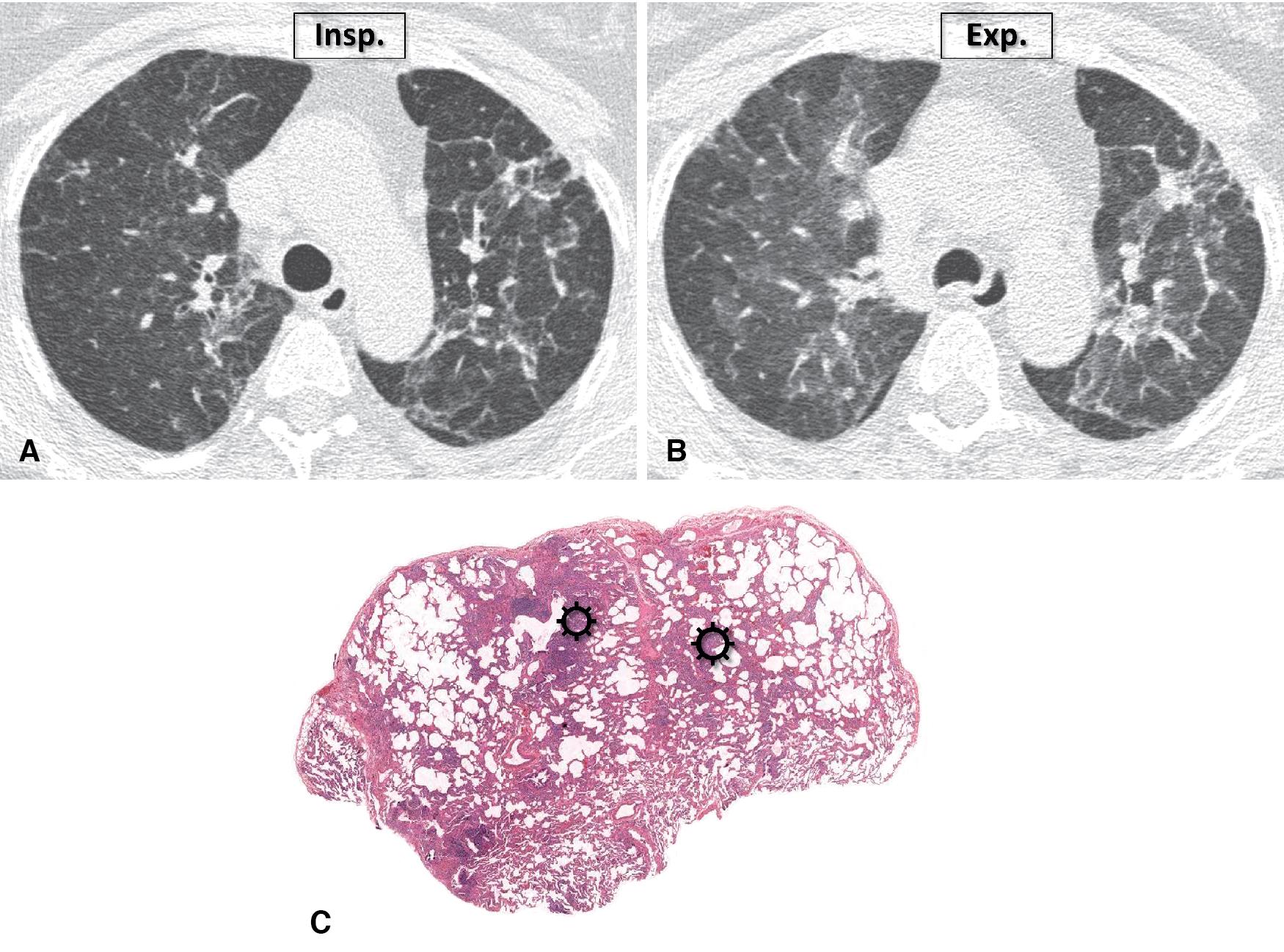
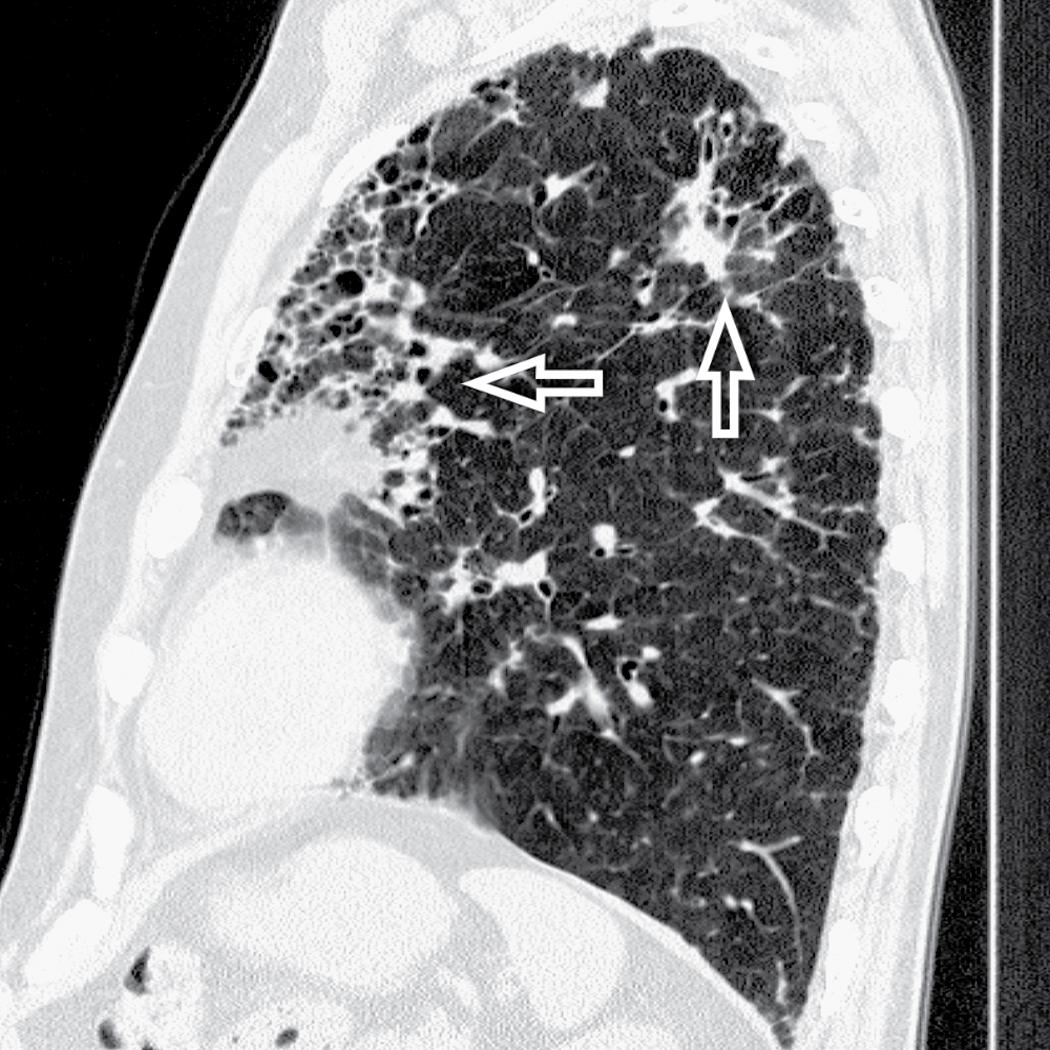
HRCT abnormalities indicative of small airway disease include the so called “three-density pattern” and/or air trapping (often in a lobular distribution); ill-defined, centrilobular nodules and/or GGOs may be also present.
The term “three-density pattern” describes the presence of three different lung densities, which some radiologists have referred to as the “headcheese sign.” This pattern emphasizes the diagnostic value of lobules with decreased attenuation and vascularity on inspiratory HRCT images, especially when concomitant with air trapping at expiration, both suggesting the presence of severe bronchiolar obstruction (see Fig. 4.51 ). ,
Sometimes fibrotic HP may present with not-typical pattern appearing similar to UIP pattern ( Fig. 4.53 ).
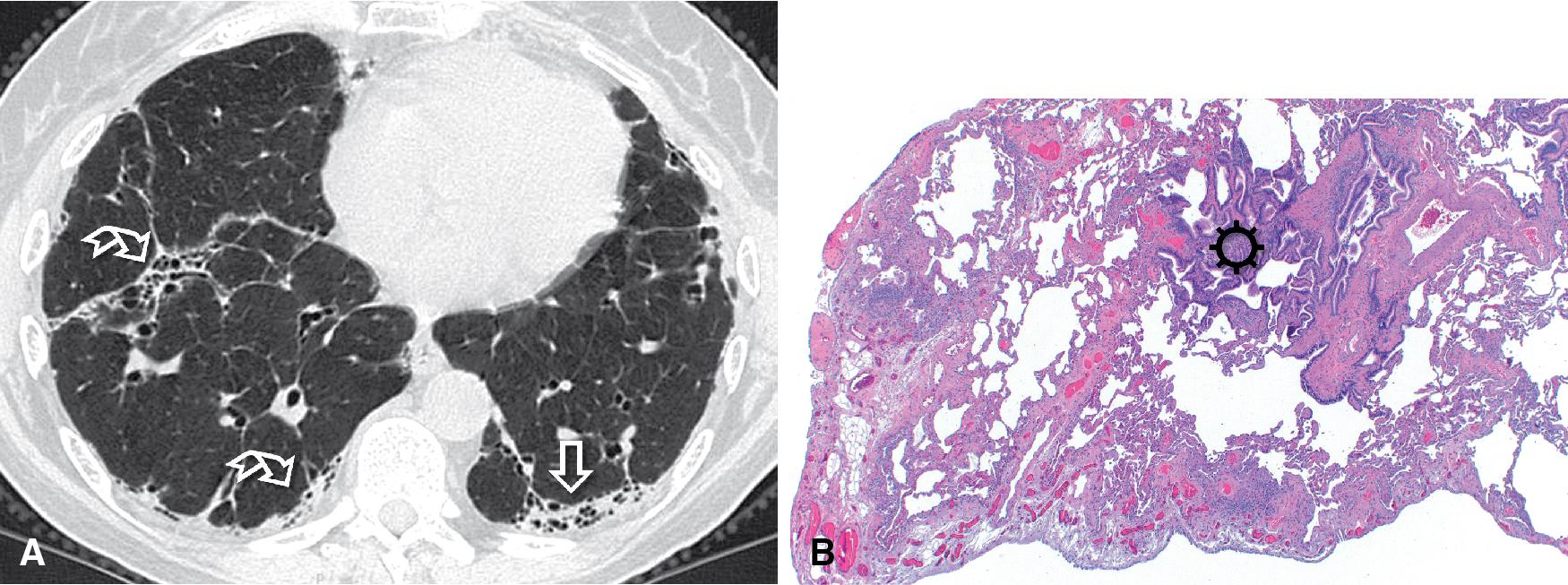
UIP is the hallmark radiologic pattern of IPF. Honeycombing is a distinguishing feature of UIP and must be present for a definite HRCT diagnosis of UIP to be made ( Fig. 4.54 ). , ,
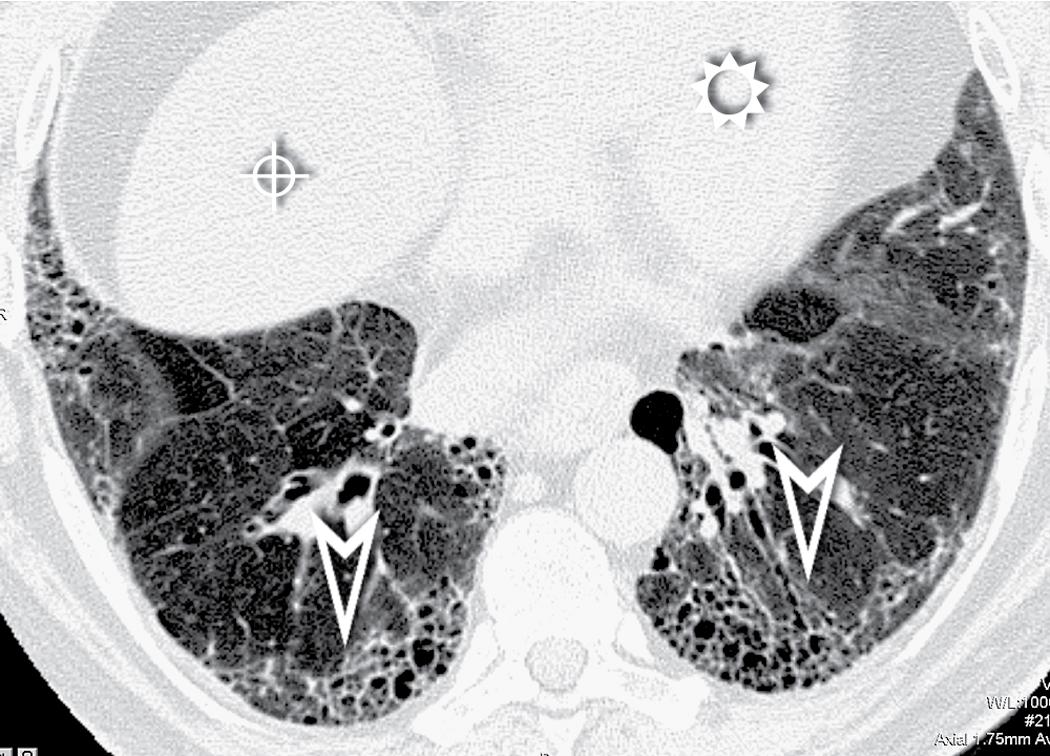
It is associated with peripheral traction bronchiectasis or bronchiolectasis. The typical distribution of UIP is subpleural with basal predominance, although some upper lobe involvement is common ( Fig. 4.55 ); in some cases, the craniocaudal distribution of UIP may be relatively uniform. Some focal areas of only slightly increased attenuation (due to uneven fibrosis) interspersed with relatively normal alveoli may coexist. Rugged pleural surfaces (owing to the tendency for fibrosis to occur in the periphery of the secondary lobule) are very frequent. Characteristically the patches of fibrosis are sharply bordered and intermingled with areas of normal parenchyma. Asymmetric disease may occur in up to 25% of cases. Several studies have demonstrated that the positive predictive value of a radiologic diagnosis of UIP on HRCT for a pathologic diagnosis of UIP is between 90% and 100%.
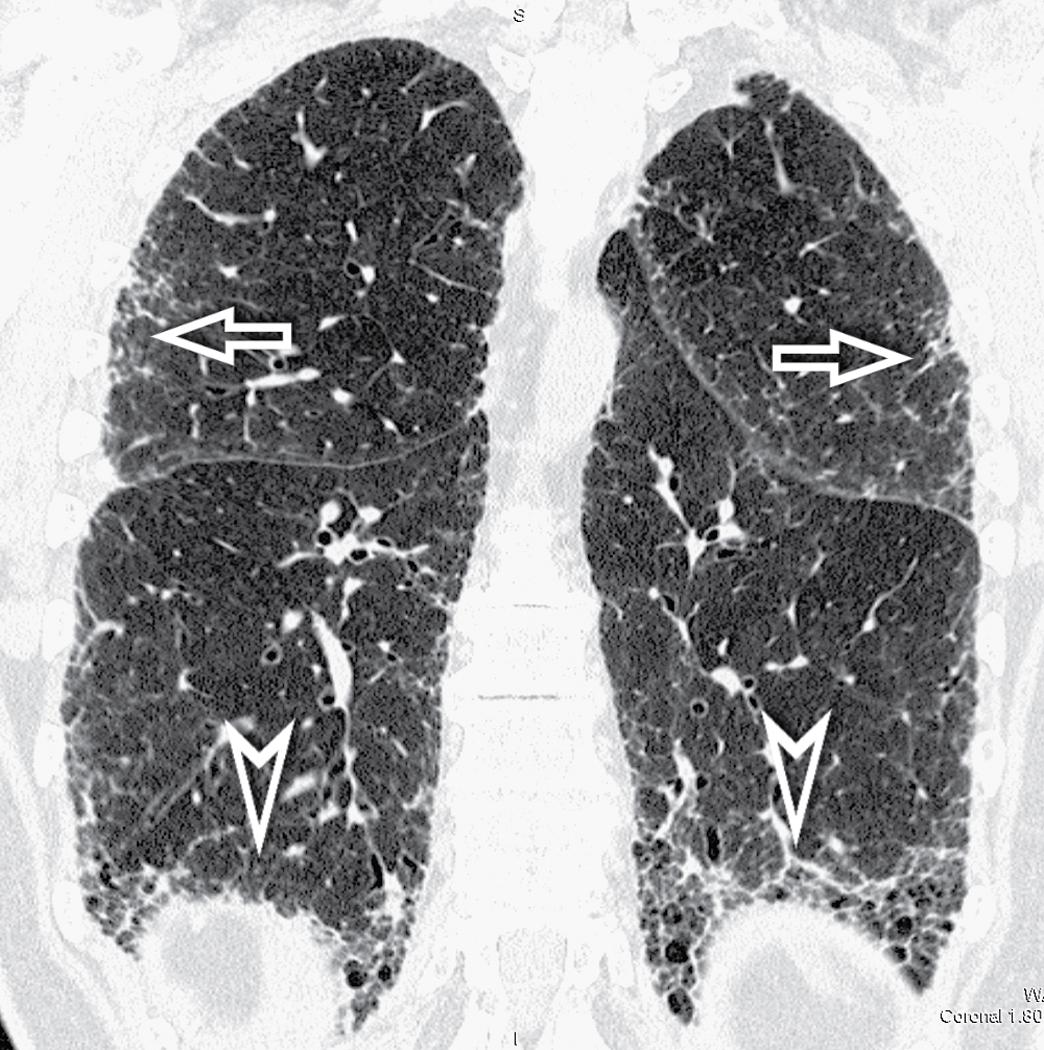
The disease is typically subpleural with some extension into the inner lung in connection with thickened vessels and ectatic bronchi. The longitudinal distribution of the lesions is noteworthy. Although the more complex lesions with traction bronchiectasis and honeycombing show middle and lower predominance, a coexisting irregular reticulation is frequently seen in the upper anterior and peripheral lung. Particularly in advanced fibrosis, the lung becomes smaller and the indirect signs of retraction and remodeling are striking.
Diagnostic problems of differential diagnosis between such areas of emphysema and honeycombing may ensue. , A mild enlargement of mediastinal lymph nodes is present in approximately 70% of cases. Occasionally calcification and even ossification can be found, both as small, nodular foci and in disseminated, dendritic form. Associated solitary pulmonary opacities from lung cancer are possible, as in all fibrotic disorders.
Some CVDs and, more rarely, drug reactions may present with features indistinguishable from idiopathic UIP. Accordingly, suspicion for the underlying disorder is mainly formulated on clinical grounds, although occasionally specific signs of the original disease are also seen radiologically ( Fig. 4.56 ).
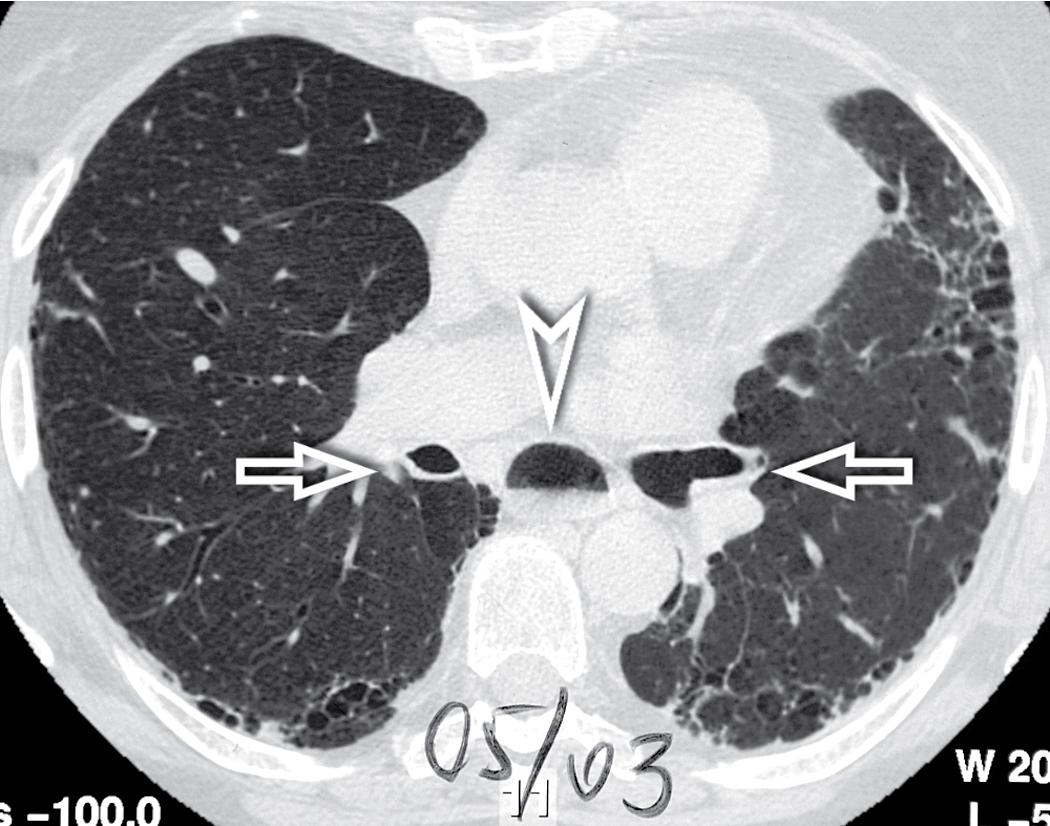
Become a Clinical Tree membership for Full access and enjoy Unlimited articles
If you are a member. Log in here